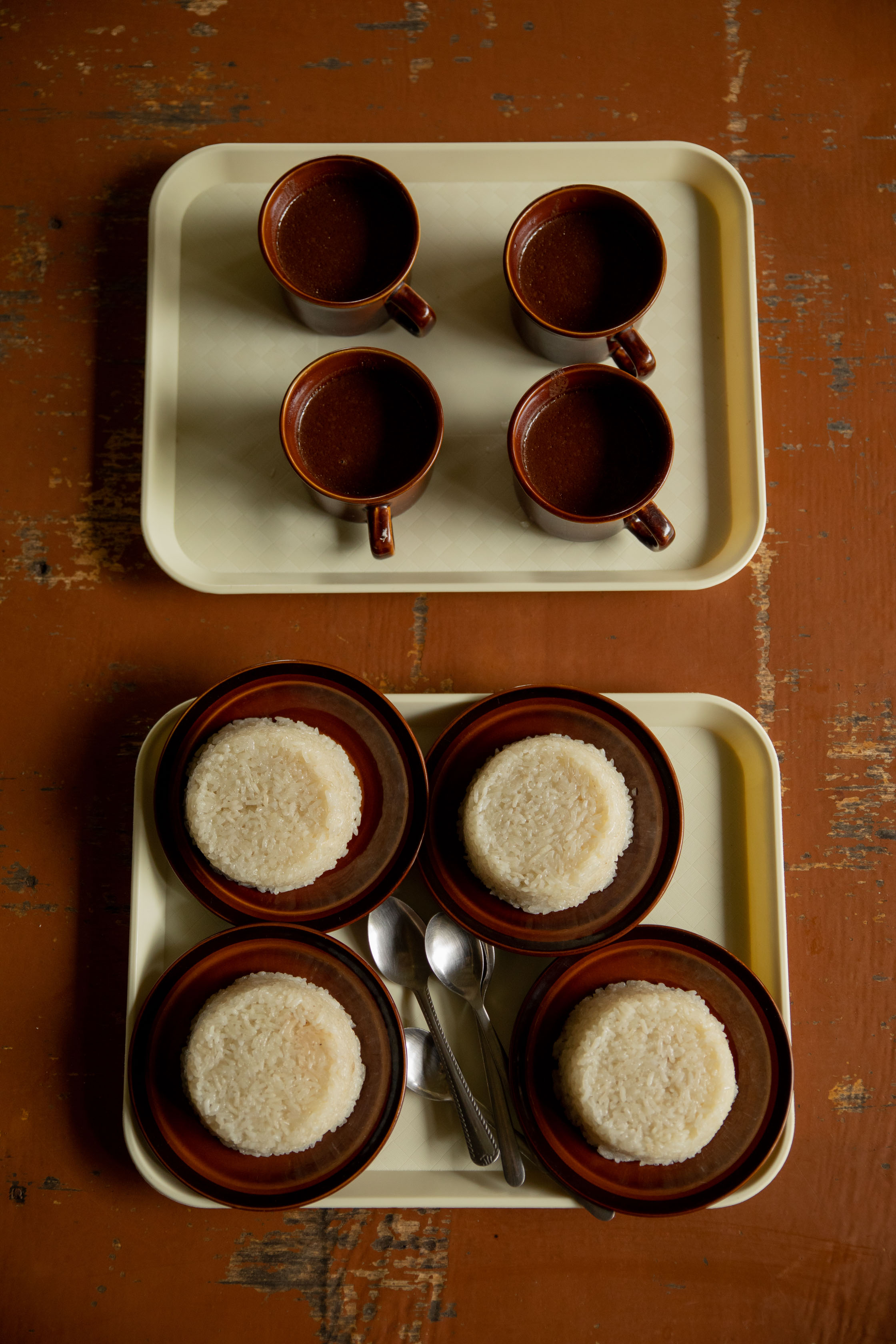A Rice Journey > Philippines
菲律賓 Philippines
text: Bea Misa Crisostomo
photography: Geric Cruz
Website:
gericcruz.com
Instagram:
@gericcruz
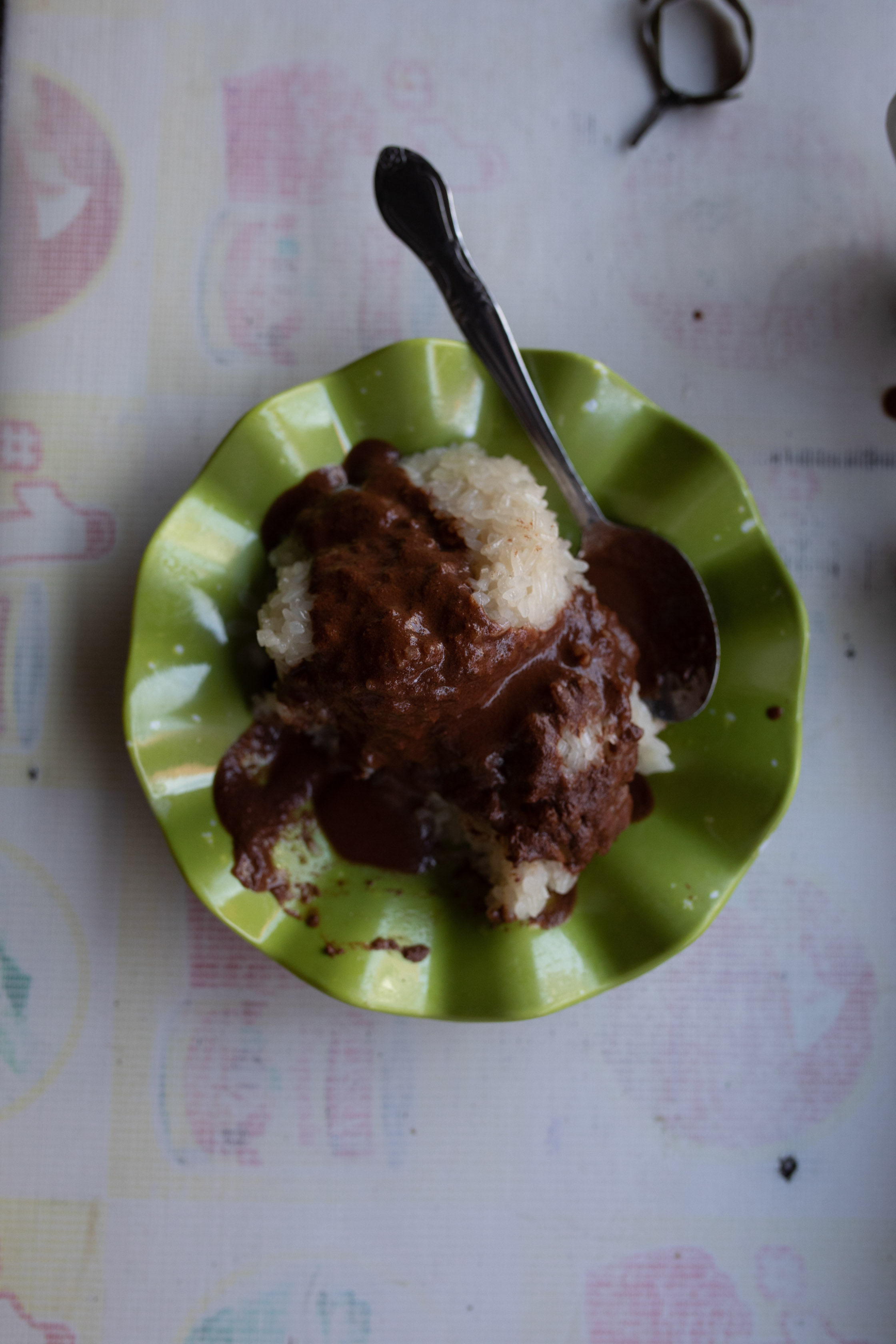

菲律賓蒸米糕與熱可可
PUTO MAYA UG TSOKOLATE
杜馬蓋地(Dumaguete)是一座靠海的大學城,位在馬尼拉以南600公里處。現在是早上五點,公有市場小吃攤(Paintan)的老舊椅凳坐滿從事各行各業的當地人,準備開啟一天的序幕。在此起彼落的杯盤碰撞聲以及茶匙的攪拌聲中,人們逐漸清醒,與真實世界中的人群與商業活動接軌。Paintan字面的意思是「溫暖人的地方」,簡單說就是一大早可以吃到熱騰騰的早餐的地方。杜馬蓋地以及其周邊地區遍佈這類型的小吃攤:有些在街角直接放上桌子,桌上堆放著摺成三角形,裡頭裝著米飯的香蕉葉,還有保溫保冷的飲料桶;有些較為固定的攤位則有招牌、座位和收銀台。不過,到目前為止,在公有市場的小吃攤還是空間最大、最有生命力的地方。三個世代以來,小吃攤是這座城市的根本,充分展現民主又放鬆的生活型態。無論天氣好壞,這些小吃攤每天供應幾百份的經典杜馬蓋地早餐——蒸米糕與熱可可(puto maya ug tsokolate)。
It is 5AM in Dumaguete, a coastal university town more than 600 kilometers south of Manila, and locals from all walks of life have plopped themselves upon the worn stools of the public market’s painitan section to start their day. The clatter of plates and the stirring of teaspoons in the air as people wake from their inner world into the reality of community and commerce.
Painitan literally means “a place where one is warmed”. In plain terms, it where one can get a hot breakfast early in the morning. The city and surrounding areas are dotted with versions of them: some just tables on street corners piled with rice-filled banana leaf triangles and insulated drink canteens, others more permanent spots with signage, seating, and counters. The public market’s painitan section, though, is by far the largest and most vibrant of them all. It has for three generations been one of the anchors of the city, demonstrating its brand of a democratic, relaxed quality of life. Every day, rain or shine, it churns out hundreds of servings of puto maya ug tsokolate, the quintessential Dumagueteño breakfast.


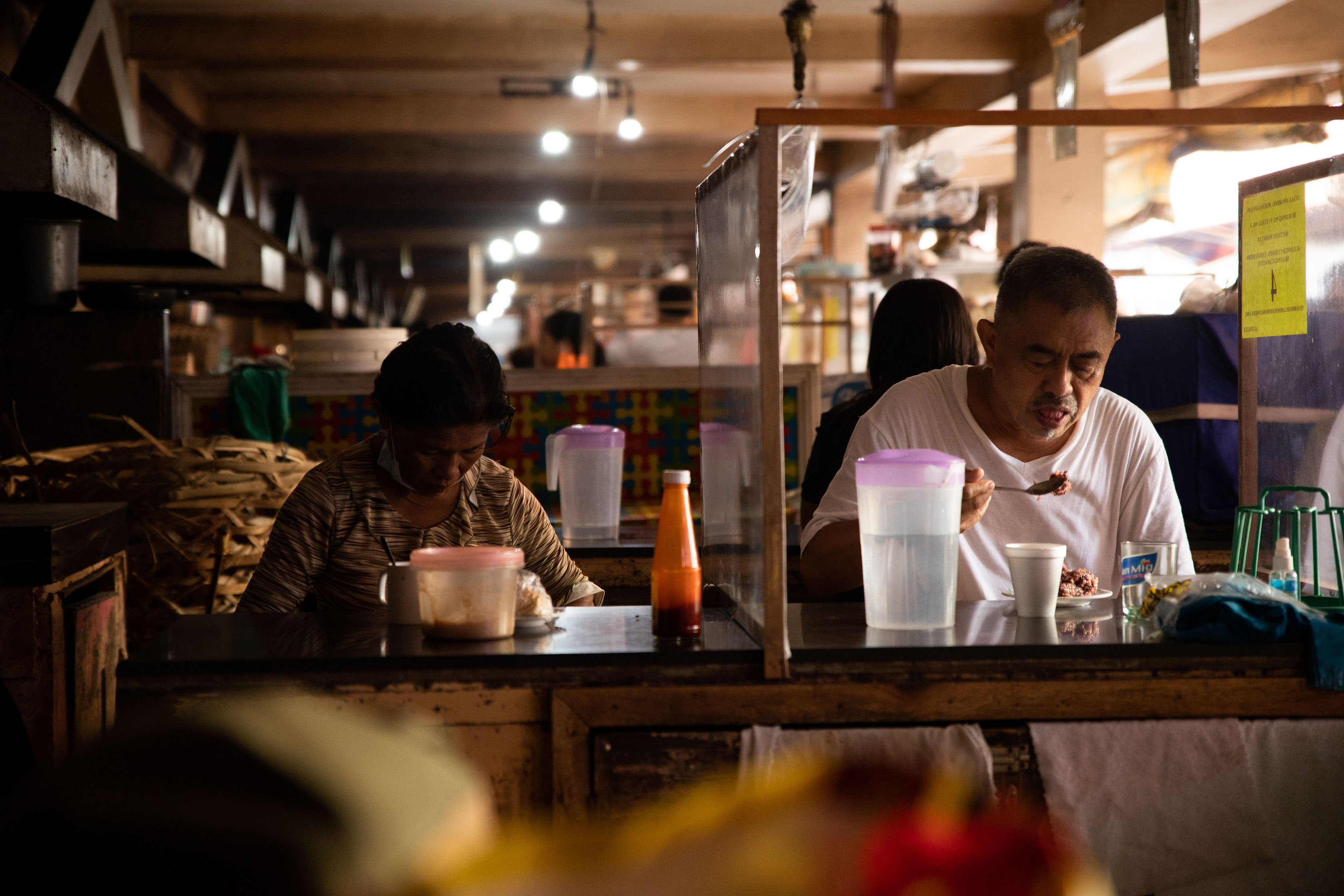



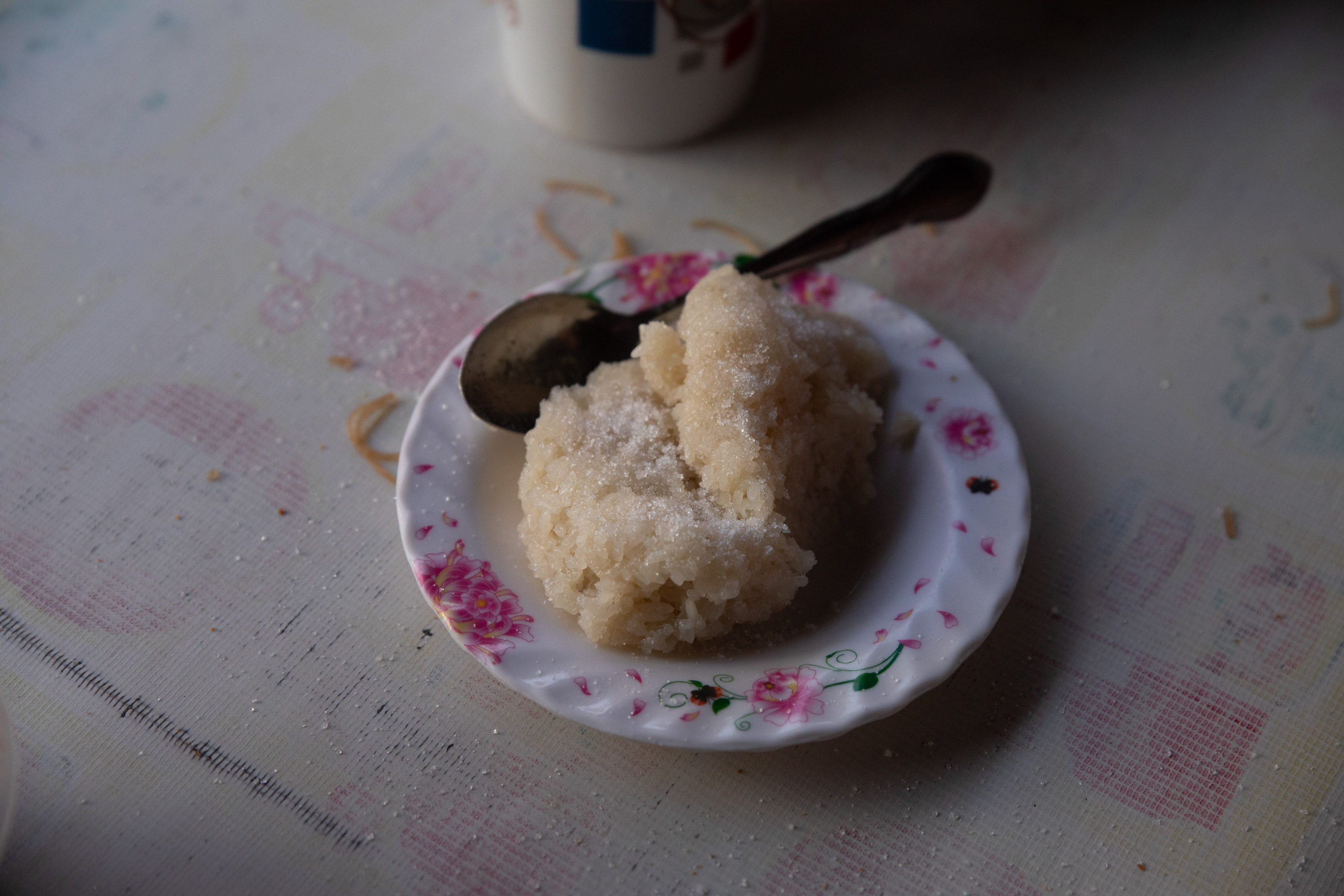

我走進市場,經過二手商品店(ukay-ukay stalls),店家在兜售叫賣50披索一條的二手牛仔褲,經過販賣雞蛋、米、豆子的婦女,還有販賣咖啡豆的臭臉老爺爺。我選了攤位編號3號的小吃攤坐下,他們的椅凳油漆斑駁,畢竟市場是將近30年前設立的。疫情之前,只有最早設立的少數攤位客人絡繹不絕。這些地方是地方政治八卦的交流地,看到國會議員有些不知所措地與漁民和電動人力車司機同坐,也不算稀奇的事。我算是內向的人,所以比較喜歡相隔幾個攤位、人較少的小吃攤,不過現在市場已經關閉,這些攤販便直接在自家住宅做生意(待會會詳細說明)。
瑪麗安妮(Mary Anne)是攤位編號3號的攤販,已經做了15年的蒸米糕。雖然她已經知道我會點什麼,她還是問我。如同90%的人,我來就是為了吃蒸米糕配熱可可,這是當地的主食。
我喊道:「我要一個紫色,一個白色,然後一份熱可可。」
I walk into the market, past the ukay-ukay stalls hawking used jeans for 50 pesos, past the lady selling eggs, rice, and beans, past the grumpy old man selling coffee and cacao beans. I sit myself down on one of the paint-chipped stools (original to when the market was built in the almost 30 years ago) at Stall Number 3. Before the pandemic, the first few stalls were perpetually full of customers; being the go-to place for local political gossip, and it was not uncommon to see congressmen and their ilk sitting side by side with fish vendors and motorized pedicab drivers. Being somewhat of an introvert, I preferred a less busy stall a few spaces down, but they have since closed their location and are selling out of their home (more on that later).
Mary Anne, who has been making puto maya for Stall Number 3 for 15 years, asks me what I want, though she already knows the answer. Like 90% of people, I am here for the local staple of puto maya and hot chocolate.
“Usa ka tapol, usa ka pilit. Ug usa ka tsokolate.” (One purple, one white. And one hot chocolate.), I declare.
瑪麗安妮(Mary Anne)是攤位編號3號的攤販,已經做了15年的蒸米糕。雖然她已經知道我會點什麼,她還是問我。如同90%的人,我來就是為了吃蒸米糕配熱可可,這是當地的主食。
我喊道:「我要一個紫色,一個白色,然後一份熱可可。」
I walk into the market, past the ukay-ukay stalls hawking used jeans for 50 pesos, past the lady selling eggs, rice, and beans, past the grumpy old man selling coffee and cacao beans. I sit myself down on one of the paint-chipped stools (original to when the market was built in the almost 30 years ago) at Stall Number 3. Before the pandemic, the first few stalls were perpetually full of customers; being the go-to place for local political gossip, and it was not uncommon to see congressmen and their ilk sitting side by side with fish vendors and motorized pedicab drivers. Being somewhat of an introvert, I preferred a less busy stall a few spaces down, but they have since closed their location and are selling out of their home (more on that later).
Mary Anne, who has been making puto maya for Stall Number 3 for 15 years, asks me what I want, though she already knows the answer. Like 90% of people, I am here for the local staple of puto maya and hot chocolate.
“Usa ka tapol, usa ka pilit. Ug usa ka tsokolate.” (One purple, one white. And one hot chocolate.), I declare.


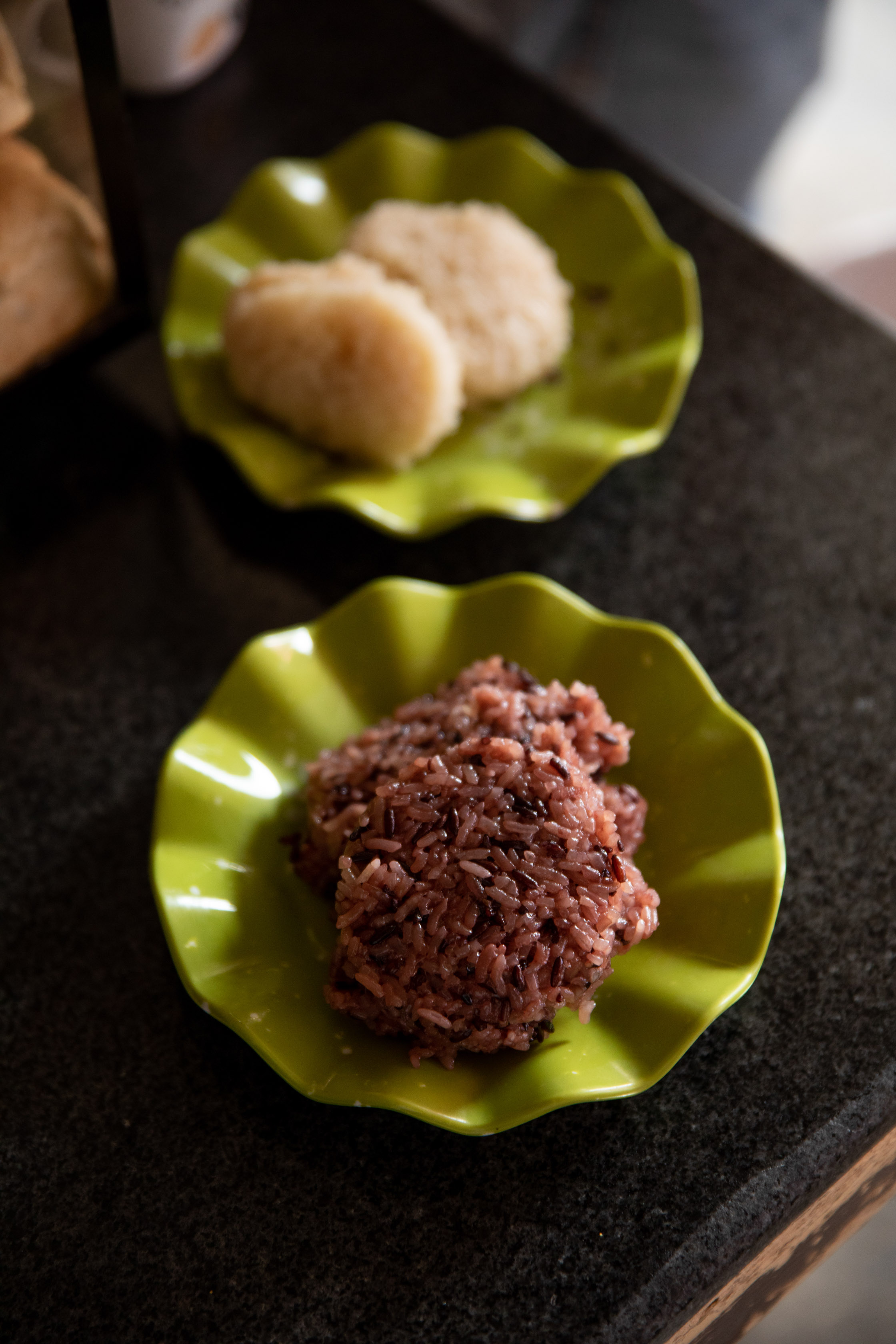
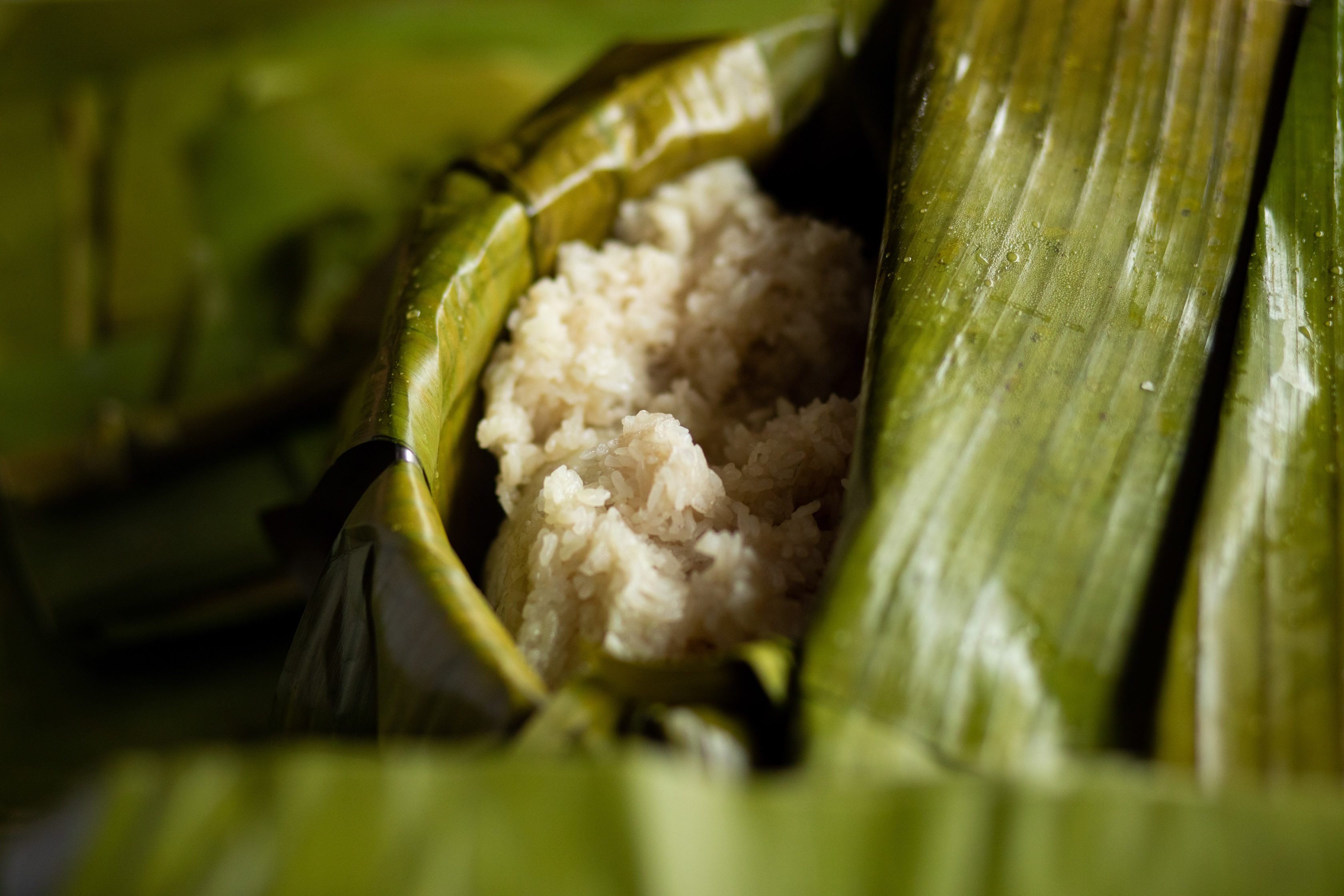
她戴上透明塑膠手套,然後剝掉包著大不鏽鋼壺的兩層香蕉葉。她用紅色的塑膠蓋(看起來是拿過濾水壺的蓋子重新利用)舀出一分剛蒸好、閃著粉紅色澤的糯米糕,放在綠色的塑膠盤上。接著她打開另一個鍋蓋,用剛剛的塑膠蓋舀出白色糯米,然後把擺好盤的綠色有摺塑膠盤擺到我面前。
瑪麗安妮走向位在攤子後面光線較暗的烹飪區,抓起高頸金屬罐(chocolatera),接著交替用手攪動木製攪拌棒(batidor)來乳化熱巧克力,讓它起泡。她把濃稠的深褐色液體倒入一個小杯子,然後把杯子放在我的食物旁。在維薩亞斯群島(the Visayas)的其他地方,通常會在蒸米糕旁放芒果來呼應這款帶有泰式和馬來西亞風情的甜糯米糕點。不過在杜馬蓋地,我遵循當地人的吃法:把蒸米糕浸在用融化的可可片(tablea)與糖製成的濃厚熱巧克力裡頭。這種熱巧克力比較接近同樣濃稠且深色的巧克力醬,比較不像全球各地喜歡的Swiss Miss充滿奶香的熱巧克力。Tablea是同樣被西班牙人殖民的墨西哥原住民留下的一樣珍貴禮物。
She pulls clear plastic gloves on and removes two layers of banana leaves that cover a large stainless steel pot. With a red plastic cap (apparently a repurposed twist-cap of a purified water jug), she scoops out freshly steamed portions of shiny pinkish sticky rice onto a green plastic plate. She uncovers another pot and again portions capfuls of white sticky rice, then lays the plastic green ruffled plate onto the table before me.
Mary Anne makes her way to the dark rear cooking area of her stall, grabs the chocolatera where the tsokolate was cooked, and gives the batidor (a kind of wooden mixing stick) some whirls between her hands, emulsifying the hot chocolate and giving it some froth. She pours the thick, dark brown liquid into a small cup and sets it down beside my food. Other parts of the Visayas pair the puto maya with mangoes, echoing the iconic Thai and Malaysian sticky rice snacks, but like most locals, I eat my puto maya drenched only in thick local hot chocolate made from dissolved tablea (potent discs of roasted and ground cacao beans) and sugar. It is closer to a thick and dark chocolate sauce than the milky Swiss Miss chocolate the whole world enjoys. An indelible gift from the native Mexicans, who were also colonized by the Spanish.
瑪麗安妮走向位在攤子後面光線較暗的烹飪區,抓起高頸金屬罐(chocolatera),接著交替用手攪動木製攪拌棒(batidor)來乳化熱巧克力,讓它起泡。她把濃稠的深褐色液體倒入一個小杯子,然後把杯子放在我的食物旁。在維薩亞斯群島(the Visayas)的其他地方,通常會在蒸米糕旁放芒果來呼應這款帶有泰式和馬來西亞風情的甜糯米糕點。不過在杜馬蓋地,我遵循當地人的吃法:把蒸米糕浸在用融化的可可片(tablea)與糖製成的濃厚熱巧克力裡頭。這種熱巧克力比較接近同樣濃稠且深色的巧克力醬,比較不像全球各地喜歡的Swiss Miss充滿奶香的熱巧克力。Tablea是同樣被西班牙人殖民的墨西哥原住民留下的一樣珍貴禮物。
She pulls clear plastic gloves on and removes two layers of banana leaves that cover a large stainless steel pot. With a red plastic cap (apparently a repurposed twist-cap of a purified water jug), she scoops out freshly steamed portions of shiny pinkish sticky rice onto a green plastic plate. She uncovers another pot and again portions capfuls of white sticky rice, then lays the plastic green ruffled plate onto the table before me.
Mary Anne makes her way to the dark rear cooking area of her stall, grabs the chocolatera where the tsokolate was cooked, and gives the batidor (a kind of wooden mixing stick) some whirls between her hands, emulsifying the hot chocolate and giving it some froth. She pours the thick, dark brown liquid into a small cup and sets it down beside my food. Other parts of the Visayas pair the puto maya with mangoes, echoing the iconic Thai and Malaysian sticky rice snacks, but like most locals, I eat my puto maya drenched only in thick local hot chocolate made from dissolved tablea (potent discs of roasted and ground cacao beans) and sugar. It is closer to a thick and dark chocolate sauce than the milky Swiss Miss chocolate the whole world enjoys. An indelible gift from the native Mexicans, who were also colonized by the Spanish.
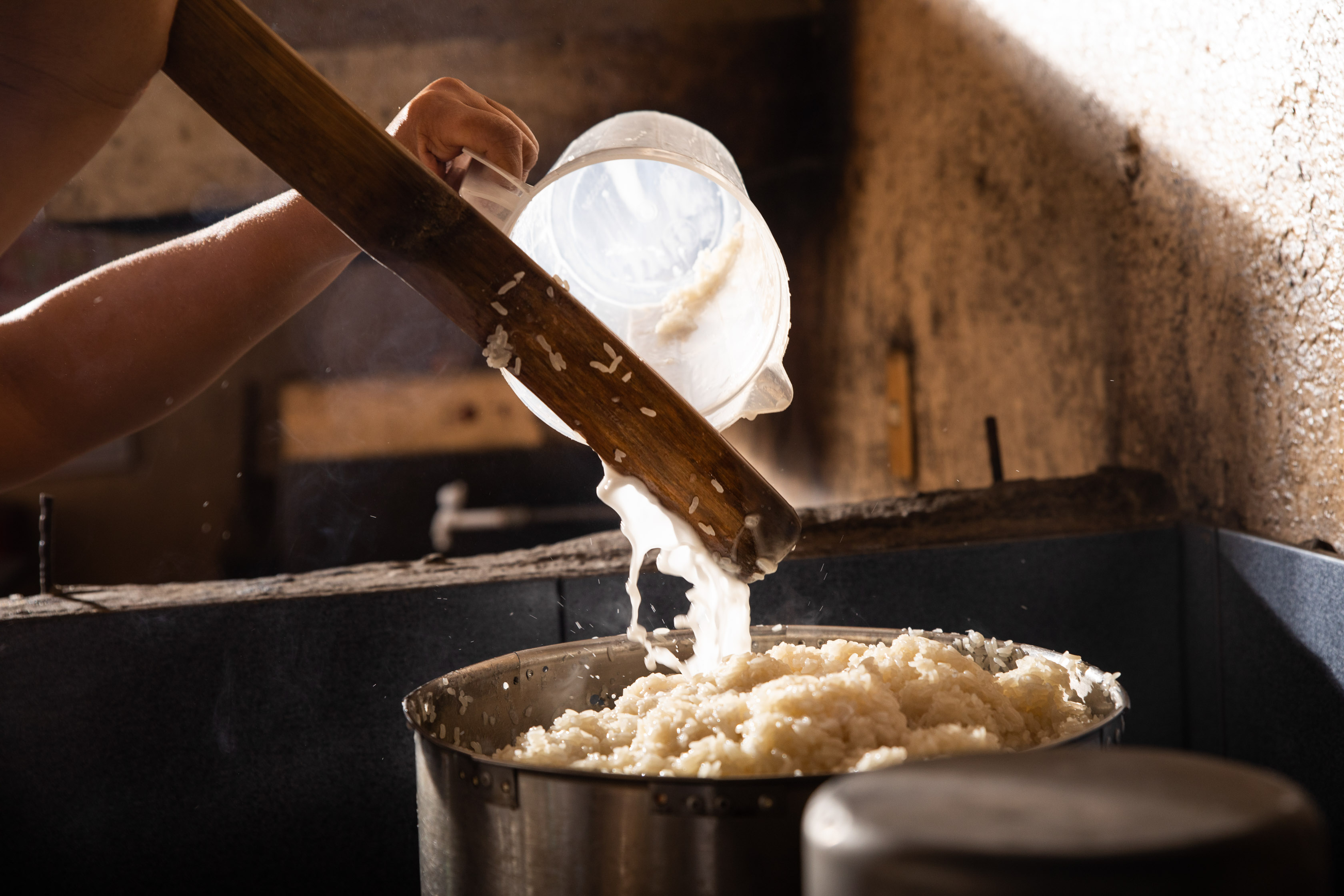


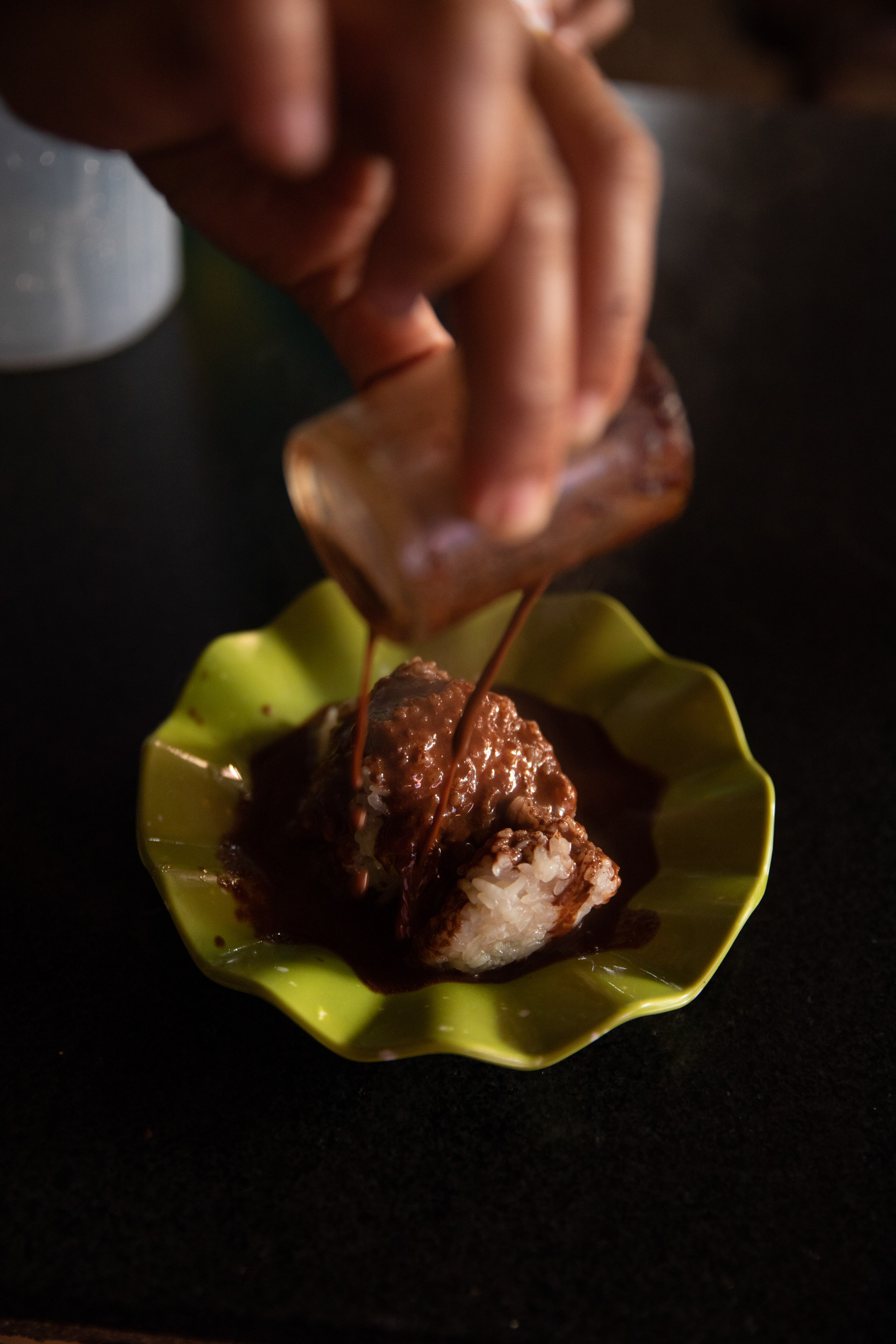
很多菲律賓以外的人,尤其是鄰近國家的亞洲人,在知道菲律賓群島曾被西班牙殖民近400年(較多人知道的是美國佔領菲律賓將近50年)時都很驚訝,這是因為菲律賓距離西班牙夠遠,很難強制大家都講西班牙文(在統治末期,只有5%的菲律賓人講西班牙文)。此外,在1億名菲律賓人中,大多數人的歐洲血統並不外顯。
由於跟西班牙距離太遠,首都的勢力鞭長莫及,因此菲律賓其實是墨西哥的管轄範圍。溫暖潮濕的中美洲也是可可樹(學名為Theobroma cacao)的產地,據說早在西元前1500年的奧爾梅克人(Olmec)就會採食可可豆。可可籽同時用在儀式中,也是一種食材,用於幾種添加香料的飲料與粥,這類食物在當地市場販賣,廣受當地菁英喜愛。當時,西班牙政府出於政治與經濟目的規劃城鎮,一位駐點在墨西哥(當時稱新西班牙〔Nueva España〕)的神父為鼓勵原住民留在這些城鎮,要求在雷伊泰省(Leyte)種植可可樹。
一位大帆船船長帶來可可樹苗,神父栽種樹苗,剩下的事情眾所週知。隨著可可樹越來越為當地所接受,農村與偏遠鄉村的日常生活也逐漸看見可可的身影。農民和鄉村居民很喜歡西班牙殖民者傳入的可可製成的飲品,他們製作可可飲品的方式與墨西哥原住民很相似。與歐洲後來改良的熱可可相比,菲律賓的可可飲更天然、顏色更深,能透過不斷攪拌乳化,並在倒出的過程中形成飲料表層的泡泡。
Many non-Filipinos, especially our Asian neighbors, are surprised to find that the archipelago was a colony of Spain for almost 400 years (more commonly known is the fact was that the US occupied us for half a century). Most people are unaware of this simply because we were a remote enough place that speaking Spanish was not effectively imposed on us (at the end of their reign, only 5% of Filipinos spoke the language), and European ancestry is not apparent in most of our 100 million people.
Being too far from Spain to be governed directly from Madrid also meant that the Philippines was administered from Mexico, and it was in those humid Mesoamerican forests that the cacao tree, Theobroma cacao, was born. It was believed to be enjoyed by the Olmec as far back as 1500 BC. The seeds were used both ritualistically and as an ingredient for several spiced drinks and porridges, enjoyed extensively by indigenous elites and served in local marketplaces. A priest, previously stationed in Mexico (then called Nueva España) had requested for seedlings to be planted out in a province called Leyte, as he was having trouble motivating the natives to stay in the towns organized for political and economic purposes by the government.
A Galleon ship captain brought the seedlings, the priest planted them out, and the rest is history. As the tree began building its life as a welcome refugee, it found its way into the lives of farmers and everyday rural folk, who took a fancy to the beverage, which was prepared pretty closely to how indigenous Mexicans did, as transposed by Spanish colonial personalities. Much more raw and dark than eventual European adaptations, it could be emulsified by beating and frothed by pouring.
由於跟西班牙距離太遠,首都的勢力鞭長莫及,因此菲律賓其實是墨西哥的管轄範圍。溫暖潮濕的中美洲也是可可樹(學名為Theobroma cacao)的產地,據說早在西元前1500年的奧爾梅克人(Olmec)就會採食可可豆。可可籽同時用在儀式中,也是一種食材,用於幾種添加香料的飲料與粥,這類食物在當地市場販賣,廣受當地菁英喜愛。當時,西班牙政府出於政治與經濟目的規劃城鎮,一位駐點在墨西哥(當時稱新西班牙〔Nueva España〕)的神父為鼓勵原住民留在這些城鎮,要求在雷伊泰省(Leyte)種植可可樹。
一位大帆船船長帶來可可樹苗,神父栽種樹苗,剩下的事情眾所週知。隨著可可樹越來越為當地所接受,農村與偏遠鄉村的日常生活也逐漸看見可可的身影。農民和鄉村居民很喜歡西班牙殖民者傳入的可可製成的飲品,他們製作可可飲品的方式與墨西哥原住民很相似。與歐洲後來改良的熱可可相比,菲律賓的可可飲更天然、顏色更深,能透過不斷攪拌乳化,並在倒出的過程中形成飲料表層的泡泡。
Many non-Filipinos, especially our Asian neighbors, are surprised to find that the archipelago was a colony of Spain for almost 400 years (more commonly known is the fact was that the US occupied us for half a century). Most people are unaware of this simply because we were a remote enough place that speaking Spanish was not effectively imposed on us (at the end of their reign, only 5% of Filipinos spoke the language), and European ancestry is not apparent in most of our 100 million people.
Being too far from Spain to be governed directly from Madrid also meant that the Philippines was administered from Mexico, and it was in those humid Mesoamerican forests that the cacao tree, Theobroma cacao, was born. It was believed to be enjoyed by the Olmec as far back as 1500 BC. The seeds were used both ritualistically and as an ingredient for several spiced drinks and porridges, enjoyed extensively by indigenous elites and served in local marketplaces. A priest, previously stationed in Mexico (then called Nueva España) had requested for seedlings to be planted out in a province called Leyte, as he was having trouble motivating the natives to stay in the towns organized for political and economic purposes by the government.
A Galleon ship captain brought the seedlings, the priest planted them out, and the rest is history. As the tree began building its life as a welcome refugee, it found its way into the lives of farmers and everyday rural folk, who took a fancy to the beverage, which was prepared pretty closely to how indigenous Mexicans did, as transposed by Spanish colonial personalities. Much more raw and dark than eventual European adaptations, it could be emulsified by beating and frothed by pouring.
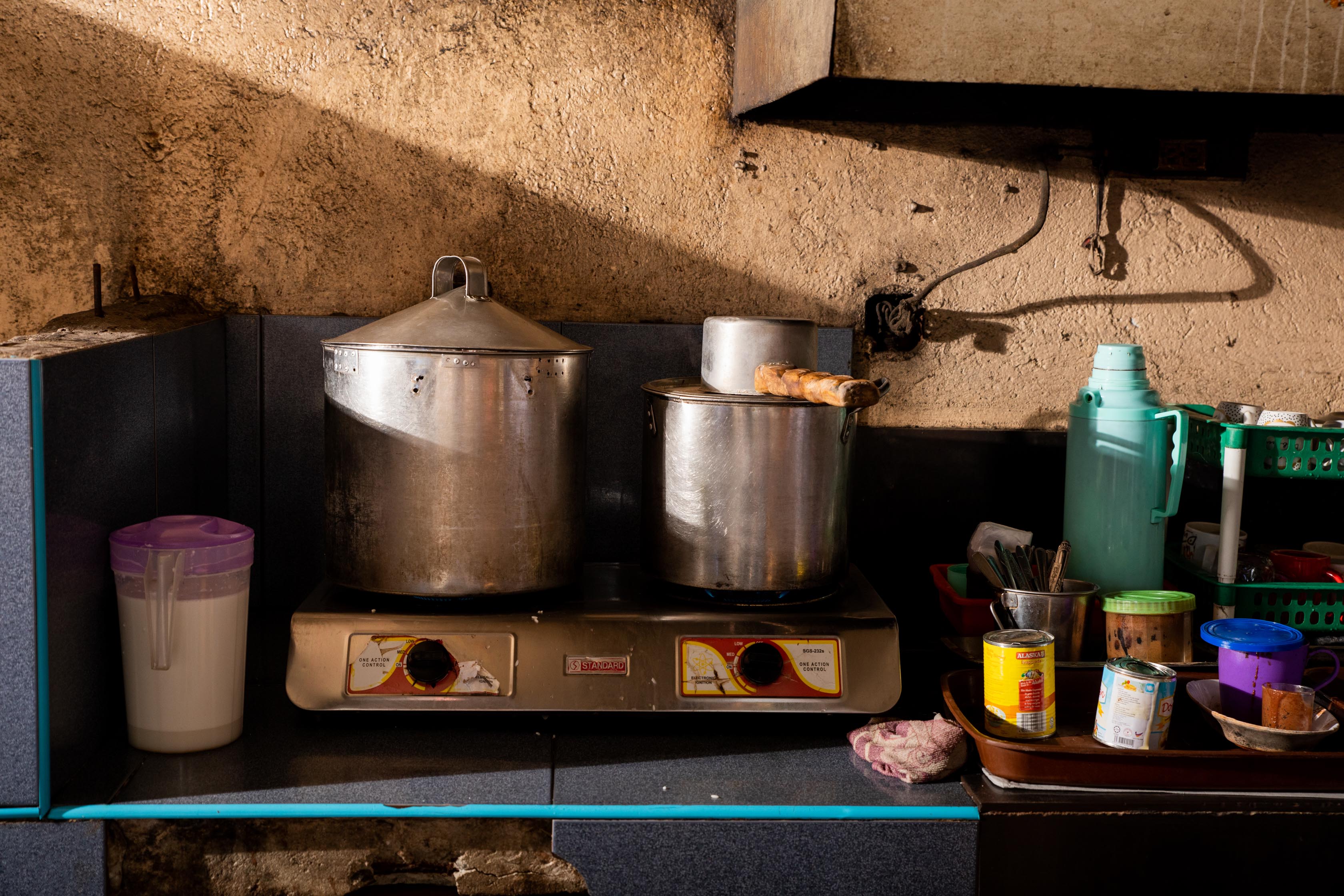

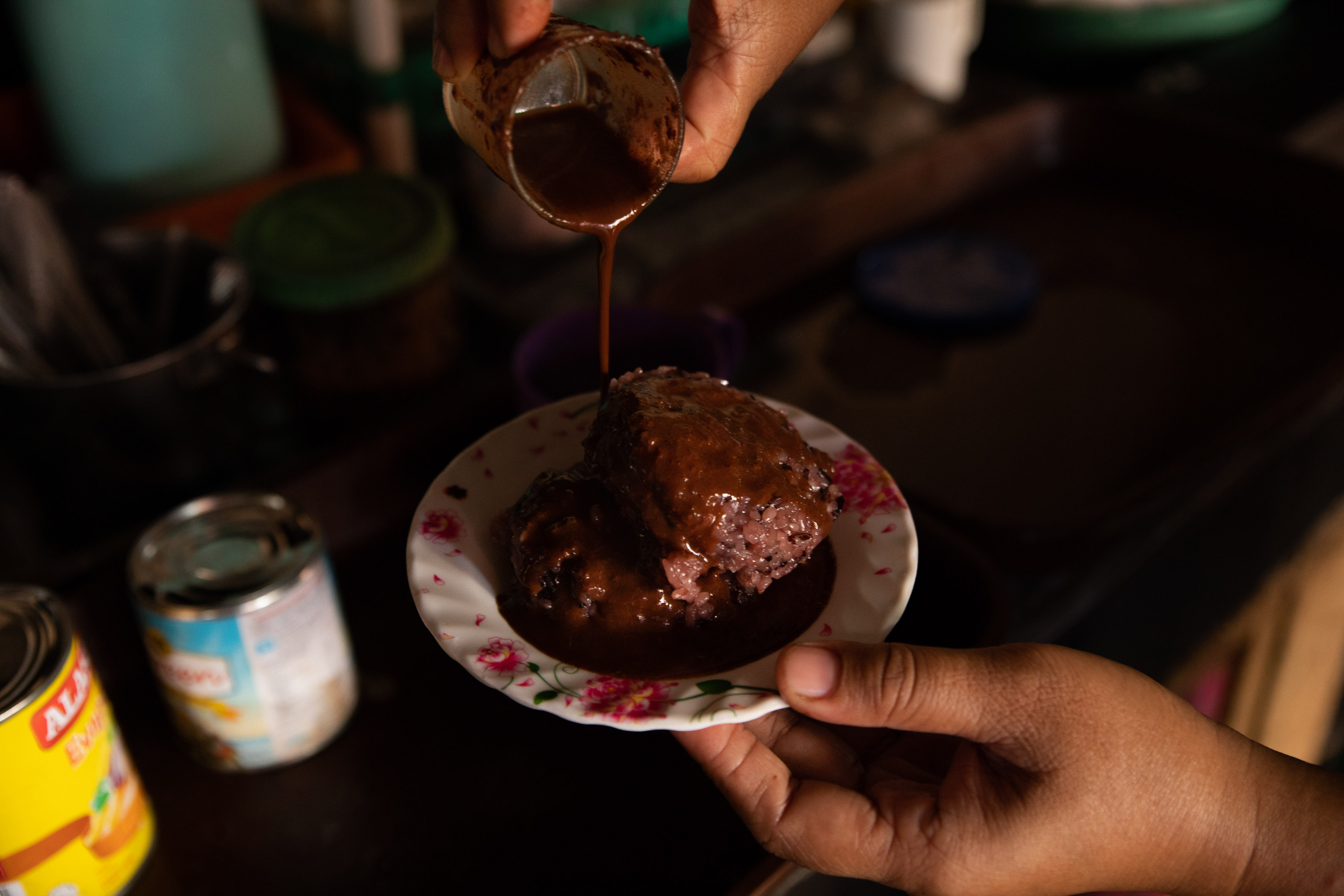
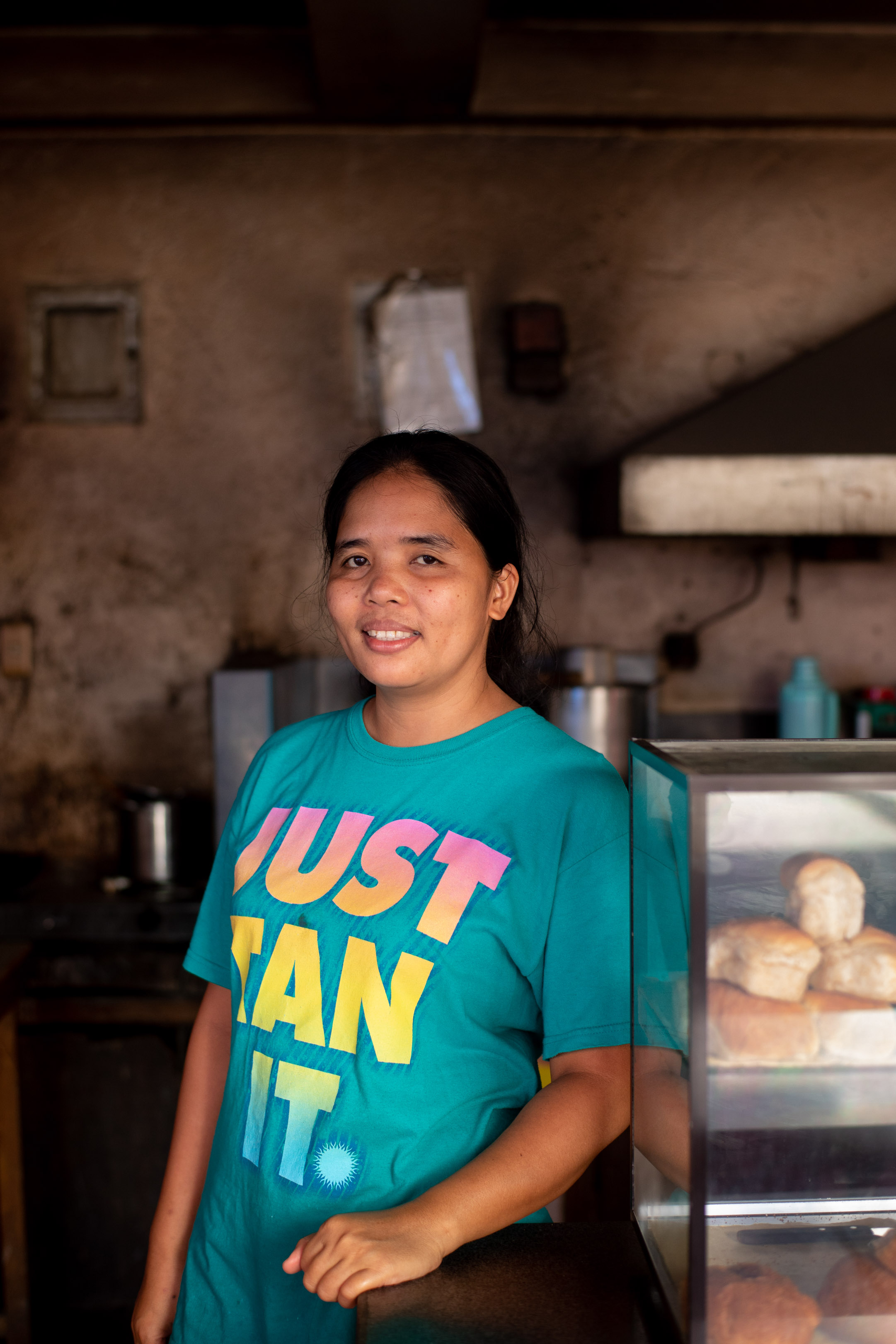

在墨西哥,可可有時會與碾碎的玉米一起拌入一款名叫champurrado的香甜飲品當中(有趣的是,champurrado這個字源自馬來文的campur,即攪拌)。在菲律賓,champurrado則變成截然不同的甜品——含有全米粒的濃稠黑巧克力粥。這項甜品充分展現當地人對可可的熱愛,將可可與當地的珍貴主食水稻(學名為Oryza sativa)結合,相關料理日漸豐富多元。
當地原住民利用這種結合,繼續煮出對可可愛好者來說完全是褻瀆可可的料理。比如說,當地人會在菲式巧克力糯米粥(champorado)中加入鹹魚乾。在有些地區,人們則會在粥的表層倒上一杯很稀的熱可可,並搭配肉類和其他鹹點一同食用。在維薩亞斯群島,這款咖啡色飲品是簡樸小吃攤的最佳拍檔,是白色與紫色蒸米糕的配料。同時,在菲律賓的西班牙仕紳會在熱可可中加入牛奶,打上奶泡,搭配像布里歐麵包的螺旋麵包(ensaimada)一起食用。
隨著時代推進,庭院栽種逐漸普及,在後院種植兩棵果樹就能供應一家所需,也能方便在家進行可可的加工處理。事實上,很多菲律賓人都懷念小時候在曬水果前先吃一口飽水鮮甜的果實,或是在較冷的季節裡,在祖母烘烤、篩選、碾碎可可豆的香味中醒來。有些人用墨西哥石磨碾碎可可,其他則是用中國圓形的濕式石磨。
Back home in Mexico, cacao was sometimes prepared with ground corn, beaten into a luscious spiced drink called champurrado (the name interestingly derived from the Malay word campur, or “to mix”). In the Philippines, champorado came to be a different animal altogether: thick dark chocolate porridge with whole grains of rice. This dish reflected the growing improvisations of a people that had fallen in love with cacao, but made it their own by marrying it with its sacred staple, Oryza sativa or rice.
With this union, the natives proceeded to do unthinkable things to cacao that chocolate-eaters may find sacrilegous. For instance, they began to pair their champorado with salted, dried fish. In some regions, they poured a cup of watery cacao over their rice and eat this soggy flavored rice alongside portions of meat or other savory dishes. The brown beverage would also become the standby of the humble painitan across the Visayas, an adjunct to the steamed white and purple sticky rice. Meanwhile Filipino-Spanish gentry frothed it with milk and served it in their home with things such as the brioche-like ensaimada.
As time passed, backyard planting became commonplace, as a couple of trees could yield enough fruit for a family’s consumption, and one could process tablea easily at home. In fact, many Filipinos wistfully recall their youth eating the sweet flesh of the fruit before laying it out to dry, or waking up during the colder seasons to the heady smells of their grandmothers roasting, winnowing, and grinding the beans, some on Mexican metates, and others through Chinese round stone wet grinders.
當地原住民利用這種結合,繼續煮出對可可愛好者來說完全是褻瀆可可的料理。比如說,當地人會在菲式巧克力糯米粥(champorado)中加入鹹魚乾。在有些地區,人們則會在粥的表層倒上一杯很稀的熱可可,並搭配肉類和其他鹹點一同食用。在維薩亞斯群島,這款咖啡色飲品是簡樸小吃攤的最佳拍檔,是白色與紫色蒸米糕的配料。同時,在菲律賓的西班牙仕紳會在熱可可中加入牛奶,打上奶泡,搭配像布里歐麵包的螺旋麵包(ensaimada)一起食用。
隨著時代推進,庭院栽種逐漸普及,在後院種植兩棵果樹就能供應一家所需,也能方便在家進行可可的加工處理。事實上,很多菲律賓人都懷念小時候在曬水果前先吃一口飽水鮮甜的果實,或是在較冷的季節裡,在祖母烘烤、篩選、碾碎可可豆的香味中醒來。有些人用墨西哥石磨碾碎可可,其他則是用中國圓形的濕式石磨。
Back home in Mexico, cacao was sometimes prepared with ground corn, beaten into a luscious spiced drink called champurrado (the name interestingly derived from the Malay word campur, or “to mix”). In the Philippines, champorado came to be a different animal altogether: thick dark chocolate porridge with whole grains of rice. This dish reflected the growing improvisations of a people that had fallen in love with cacao, but made it their own by marrying it with its sacred staple, Oryza sativa or rice.
With this union, the natives proceeded to do unthinkable things to cacao that chocolate-eaters may find sacrilegous. For instance, they began to pair their champorado with salted, dried fish. In some regions, they poured a cup of watery cacao over their rice and eat this soggy flavored rice alongside portions of meat or other savory dishes. The brown beverage would also become the standby of the humble painitan across the Visayas, an adjunct to the steamed white and purple sticky rice. Meanwhile Filipino-Spanish gentry frothed it with milk and served it in their home with things such as the brioche-like ensaimada.
As time passed, backyard planting became commonplace, as a couple of trees could yield enough fruit for a family’s consumption, and one could process tablea easily at home. In fact, many Filipinos wistfully recall their youth eating the sweet flesh of the fruit before laying it out to dry, or waking up during the colder seasons to the heady smells of their grandmothers roasting, winnowing, and grinding the beans, some on Mexican metates, and others through Chinese round stone wet grinders.


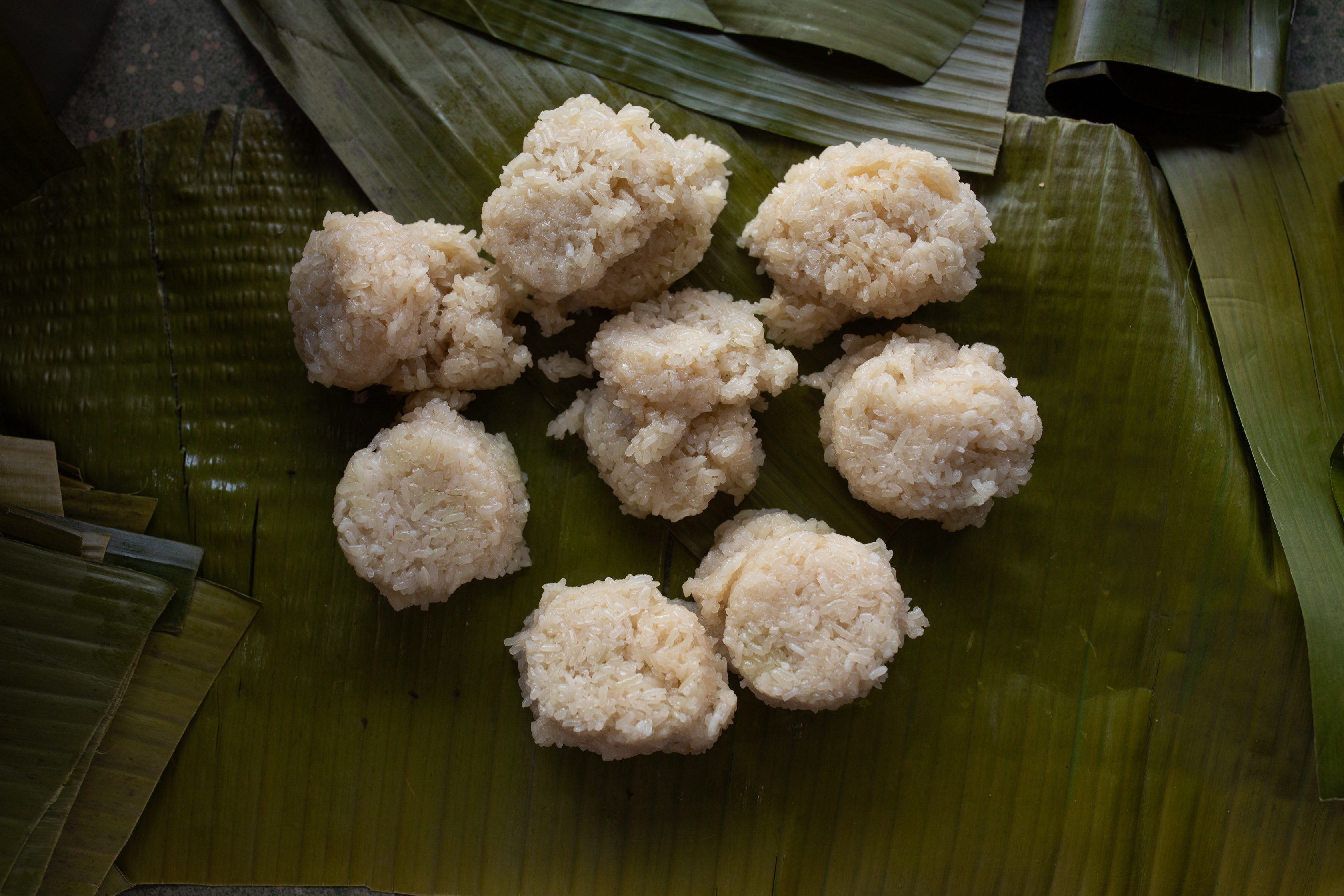






阿莫姊姊 Ate Meldy
依莫達・奧古斯汀,或稱阿莫姊姊(Ate Meldy)是我常光顧的攤販(suki painitan vendor),意即我是她的常客。阿莫姊姊的小吃攤編號是4號(攤位名稱沿用外婆的名字「Mameng’s」,而外婆的手藝是向她母親學的),她從青少年時期就開始經營這個小吃攤。她利用為顧客擺上餐盤水杯時,不著痕跡地觀察、留意顧客的特徵。我被她富有感染力的微笑吸引,後來發現她泡的熱可可乳化的非常綿密,甜度剛剛好。八年來,她帶給我很多愉快的談話,也主動提供很多建議。不過因為疫情的關係,她收了市場的小吃攤,把自己家的前半部分改裝成小吃攤,早晨時分座位總是坐滿,鄰居和路人都很喜歡她的蒸米糕和熱可可。
我請她特別撥出白天時間示範準備米糕的過程,不然我就得犧牲睡眠了。蒸米糕小吃攤販的作息和世界各地的路邊小吃攤販一樣,基本上是做大夜班(00:00~8:00)。
Imelda Agustin, or Ate Meldy, is my suki painitan vendor, that is, I am her regular. Operating Stall Number 4 at the market (named “Mameng’s” after her grandmother, who herself learned the craft from her mother) since she was a teen, she effortlessly keeps tabs with her customers while dispensing platters and cups nonstop. I was attracted to her infectuous smile and found her cacao to be well-emulsified, with just the right level of sweetness. She has been my source of pleasant conversation and unsolicited advice for about eight years now. However, because of the pandemic, she closed her market stall and turned the front portion of her home into a painitan. The tables are full at daybreak, her neighbors and other passers-by enjoying her puto maya and chocolate.
I ask her to demonstrate her cooking process, but at a special daytime schedule. Otherwise I would have to skip sleep for the day––puto maya vendors, like many street food entrepreneurs around the world, run on a sort of graveyard shift.

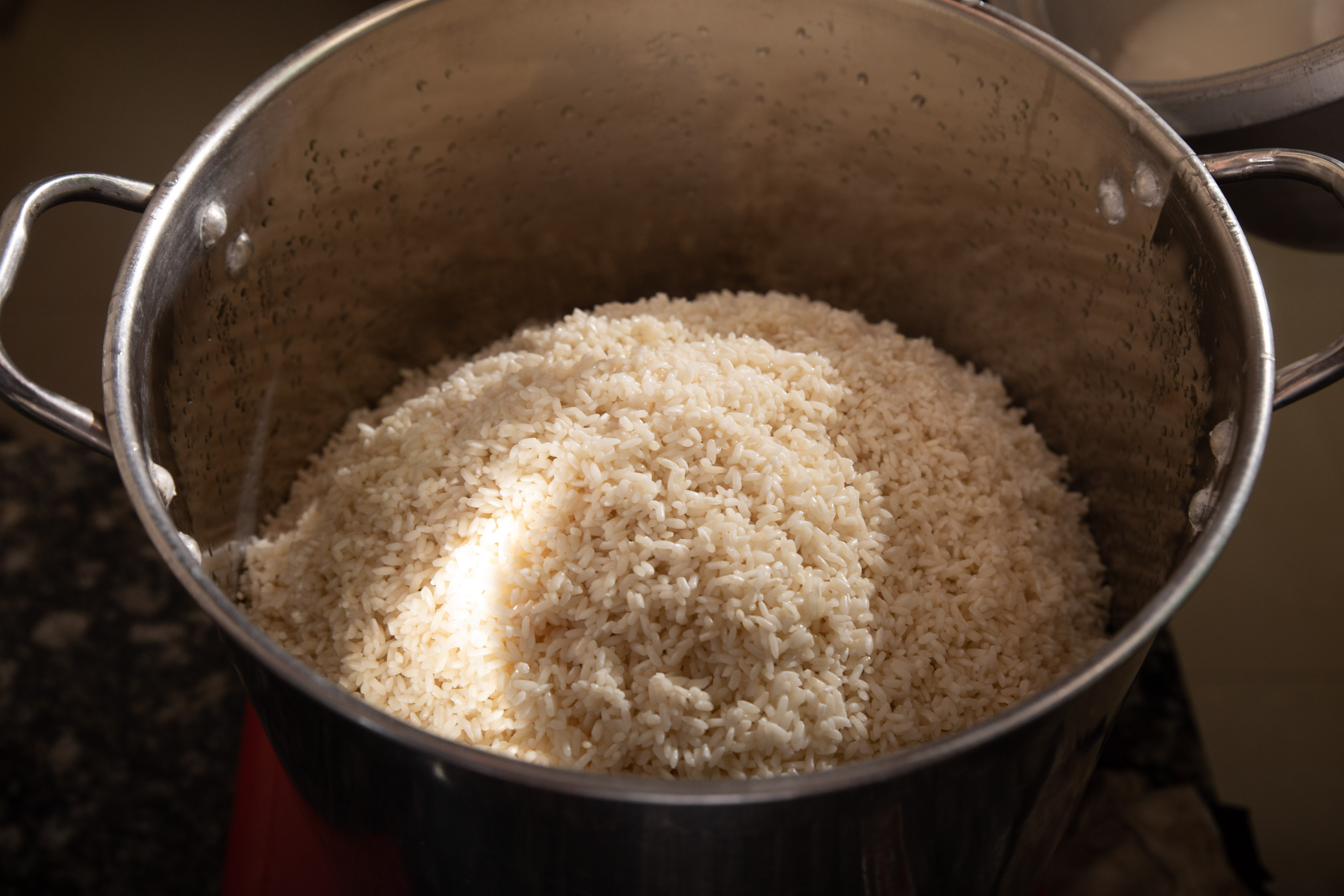
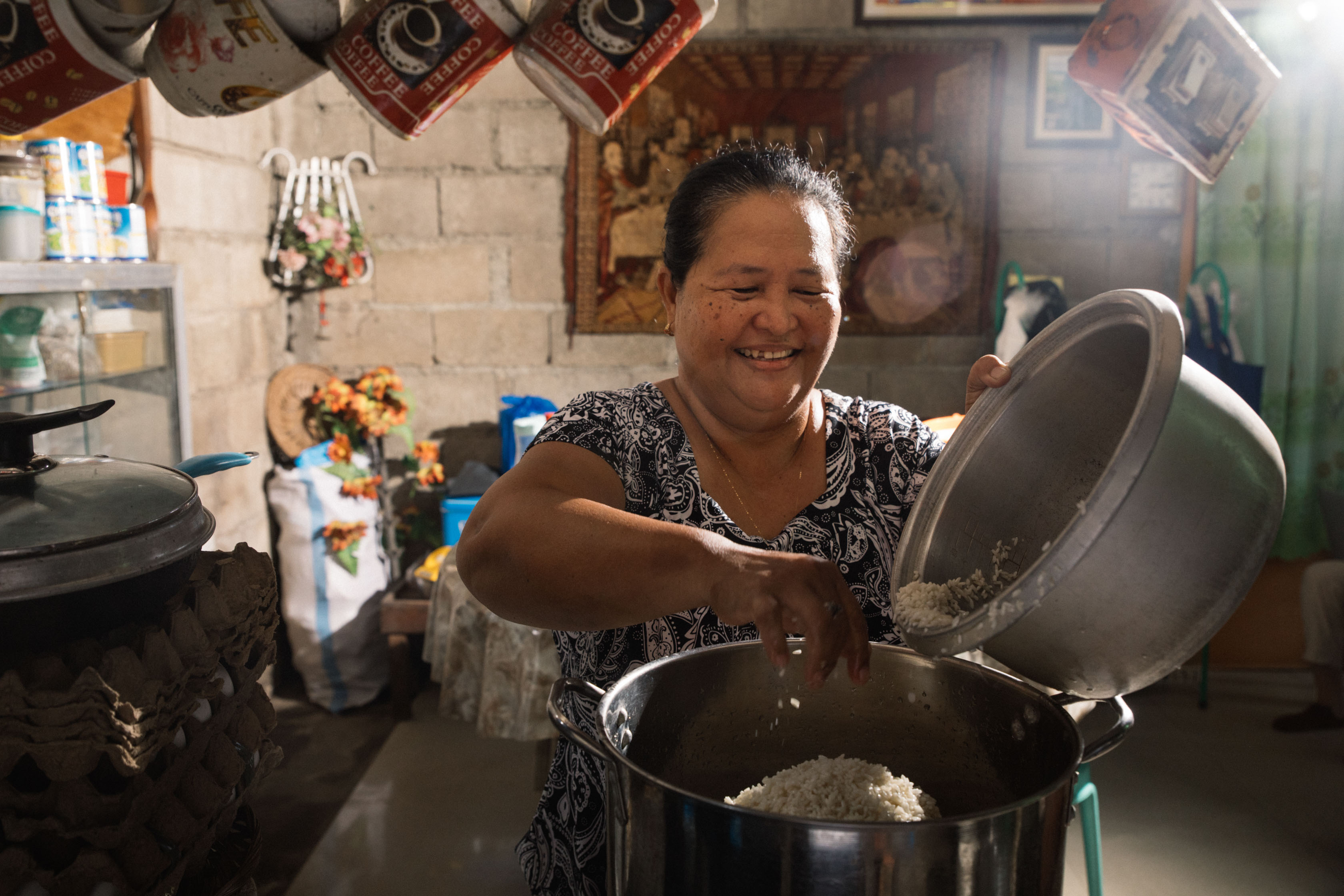
阿莫姊姊通常凌晨一點起床泡糯米,好在早上五點的時候糯米剛好軟到可以開始蒸煮。如果提早幾個小時開始蒸煮糯米,米粒會太硬,也會失去扎實的口感。現在最受小吃攤販歡迎的糯米是越南產的「青蛙王子」(“Frog Prince”),這家生產的糯米不貴,蒸煮後也較能維持形狀。以往白糯米(pilit)是由附近的希亞頓(Siaton)鎮供應,不過最近菲國政府移除關稅之後,國內便充斥較便宜的進口米。而現在普遍認為,以做生意來說,當地產的糯米「太小、顏色不夠白、口感太軟糯」。
在凌晨三點左右的時候,阿莫姊姊瀝乾糯米後,就把糯米倒進又大又深的蒸籠,裡頭的水早已煮沸。接著她開始萃取椰奶,用長刀(sundang)的波浪彎曲處或開山刀大力撬開椰子褐色的外殼,並讓椰汁徹底流出。她坐在木製長板刨絲刀上,身體稍微前傾,用身體的力量把椰肉壓在鐵製刨刀上,以規律的律動刨椰肉,刀下的臉盆接著刨下的椰肉絲。待到臉盆的椰肉絲堆成小山的時候,她便用手畫圓把椰肉絲攪下來,然後在臉盆中倒入自來水。
為萃取出香甜乳白的椰奶,阿莫姊姊把浸潤的椰肉聚攏,用力擠捏讓椰奶流出,再輕柔地把擠過的椰肉條放進乾淨的臉盆,待會再萃取一次。挑出椰奶的雜質後,她把糖和鹽加入椰奶,好讓椰奶能在蒸糯米時能均勻的分佈。(在海洋另一端的宿霧島上,當地人在這個階段會在椰奶中加入薑片,不過杜馬蓋地人說,加薑片會讓米糕吃起來更像另一款糯米甜點(kakanin),或讓米糕吃起來就跟其他糯米甜點一樣。)
She usually wakes up at around 1AM to soak the sticky rice in water, so the grains soften just enough to cook in time for 5AM––unfortunately, doing it hours earlier will make the rice congeal and lose its firm texture when cooked. The particular rice that is popular amongst the vendors now is the “Frog Prince” brand from Vietnam, which is inexpensive and retains its shape better. Historically, the nearby town of Siaton was the source of pilit or white sticky rice, but recent removal of tariffs by the national government has flooded the country with cheaper imports. Traditional local rice is now perceived to be too “small, off-white, and mushy” for commerce.
At around 3AM, Ate Meldy drains the rice and heaps it onto a large, deep steamer with already boiling water. She then begins the process of extracting the coconut milk. A strong whack with the curving bulge of a sundang or machete blade cracks the brown shell open, and the sweet water must be released and discarded. Sitting on a wooden bench grater, she leans forward slightly and rhythmically scrapes the bright white meat into a basin, using her body weight to press the inner part of the shell against the protruding iron grater. Once the basin has a tiny mountain of fluffy shreds of coconut, she skims it over in a circular motion with her hand, and then pours tap water on it.
To extract the sweet, white milk, she gathers the soaked meat up and squeezes the liquid out, heaping the spent strands gently into a clean basin for another extraction. After sieving out errant bits, she adds sugar and salt which the milk will help distribute throughout the steamed rice. (Across the ocean, in the island of Cebu, this is about the time when one would slip in some slivers of ginger, but Dumagueteños claim that makes the puto taste like another kakanin or rice snack altogether.)
在凌晨三點左右的時候,阿莫姊姊瀝乾糯米後,就把糯米倒進又大又深的蒸籠,裡頭的水早已煮沸。接著她開始萃取椰奶,用長刀(sundang)的波浪彎曲處或開山刀大力撬開椰子褐色的外殼,並讓椰汁徹底流出。她坐在木製長板刨絲刀上,身體稍微前傾,用身體的力量把椰肉壓在鐵製刨刀上,以規律的律動刨椰肉,刀下的臉盆接著刨下的椰肉絲。待到臉盆的椰肉絲堆成小山的時候,她便用手畫圓把椰肉絲攪下來,然後在臉盆中倒入自來水。
為萃取出香甜乳白的椰奶,阿莫姊姊把浸潤的椰肉聚攏,用力擠捏讓椰奶流出,再輕柔地把擠過的椰肉條放進乾淨的臉盆,待會再萃取一次。挑出椰奶的雜質後,她把糖和鹽加入椰奶,好讓椰奶能在蒸糯米時能均勻的分佈。(在海洋另一端的宿霧島上,當地人在這個階段會在椰奶中加入薑片,不過杜馬蓋地人說,加薑片會讓米糕吃起來更像另一款糯米甜點(kakanin),或讓米糕吃起來就跟其他糯米甜點一樣。)
She usually wakes up at around 1AM to soak the sticky rice in water, so the grains soften just enough to cook in time for 5AM––unfortunately, doing it hours earlier will make the rice congeal and lose its firm texture when cooked. The particular rice that is popular amongst the vendors now is the “Frog Prince” brand from Vietnam, which is inexpensive and retains its shape better. Historically, the nearby town of Siaton was the source of pilit or white sticky rice, but recent removal of tariffs by the national government has flooded the country with cheaper imports. Traditional local rice is now perceived to be too “small, off-white, and mushy” for commerce.
At around 3AM, Ate Meldy drains the rice and heaps it onto a large, deep steamer with already boiling water. She then begins the process of extracting the coconut milk. A strong whack with the curving bulge of a sundang or machete blade cracks the brown shell open, and the sweet water must be released and discarded. Sitting on a wooden bench grater, she leans forward slightly and rhythmically scrapes the bright white meat into a basin, using her body weight to press the inner part of the shell against the protruding iron grater. Once the basin has a tiny mountain of fluffy shreds of coconut, she skims it over in a circular motion with her hand, and then pours tap water on it.
To extract the sweet, white milk, she gathers the soaked meat up and squeezes the liquid out, heaping the spent strands gently into a clean basin for another extraction. After sieving out errant bits, she adds sugar and salt which the milk will help distribute throughout the steamed rice. (Across the ocean, in the island of Cebu, this is about the time when one would slip in some slivers of ginger, but Dumagueteños claim that makes the puto taste like another kakanin or rice snack altogether.)
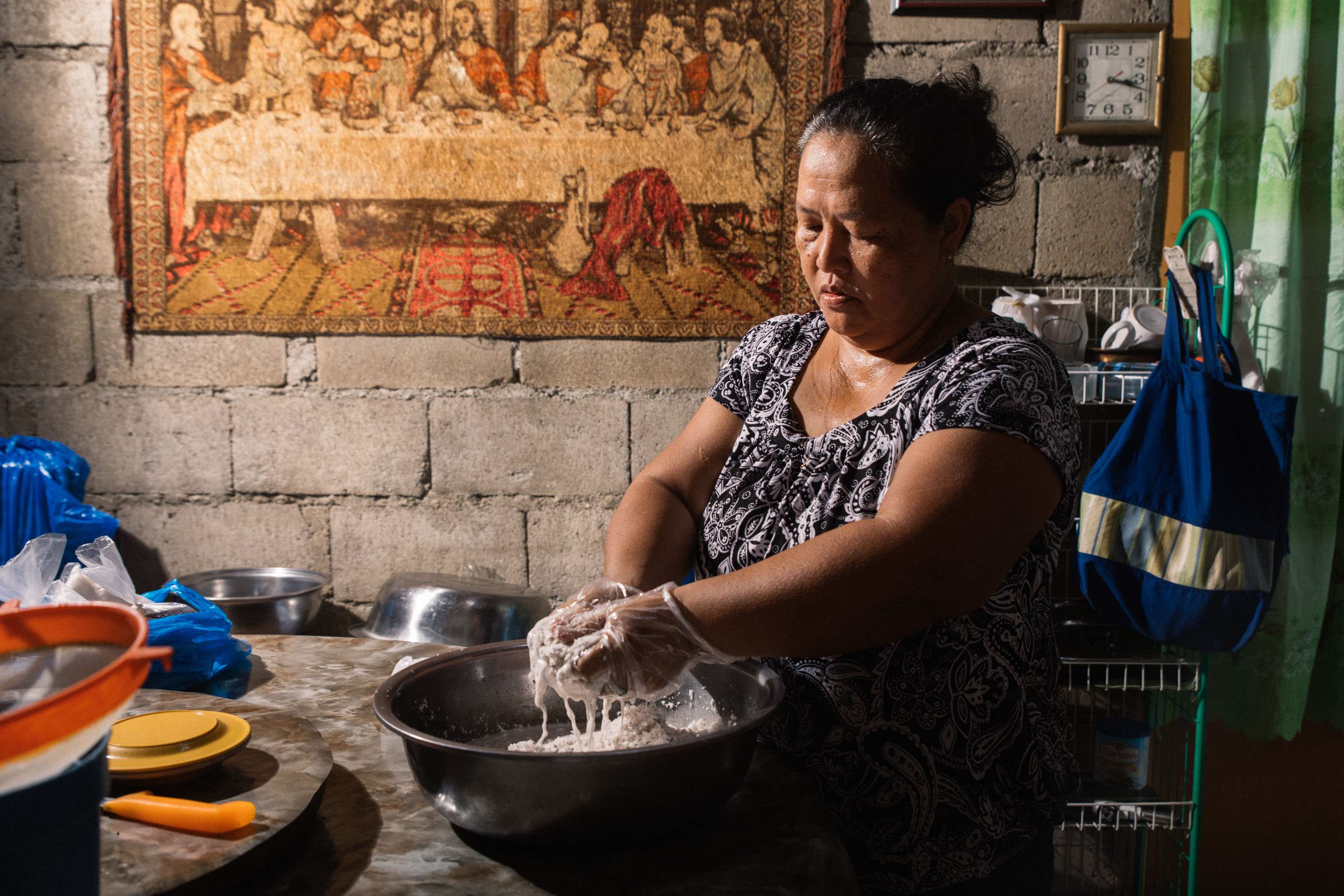



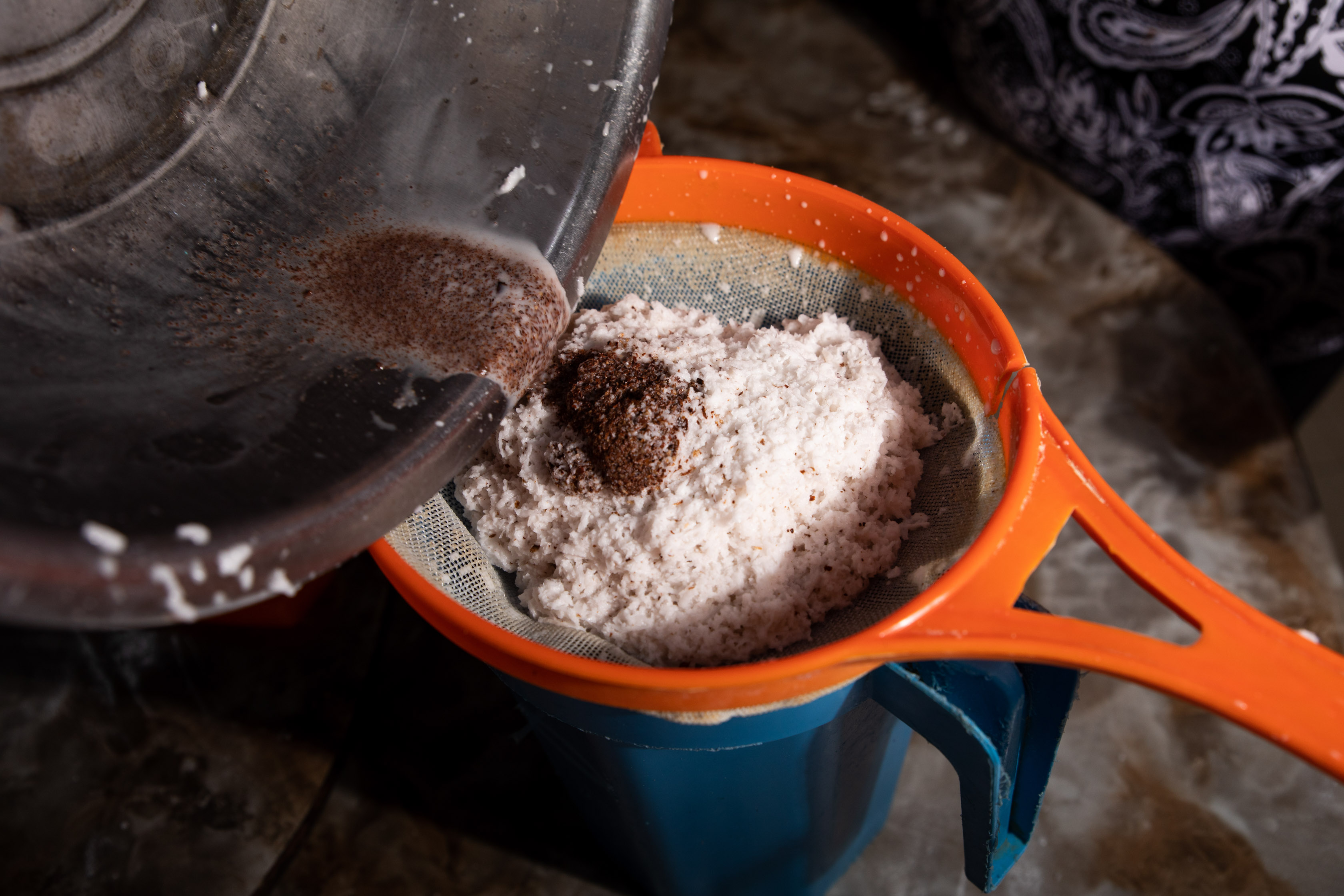


阿莫姊姊掀起蓋子,在蒸氣竄出的時候反覆戳著半熟的米糕各處,好讓米糕均勻熟透。蓋上蓋子後,我們繼續聊了30分鐘,談論生活、談論疫情對她的生意造成什麼影響。她雖然收了在公有市場的攤子,但平日她仍繼續賣蒸米糕,差不多是23公斤的糯米能製作的份量,而週末的份量是平日的兩倍。現在她每週休兩天,好讓自己在為了做米糕而起得比雞早的大半輩子中獲得一些休息時間。她笑著說,她還需要供養自己的孩子到他們實習結束,也指出家中她想整修的地方。隨後她起身去加熱在我們來之前就已經做好的熱可可。
米糕終於蒸好的時候就會從蒸籠裡拿出來,淋上椰奶。木製飯勺再次出場,不過這次是為了均勻攪拌糯米和餡料。短暫蓋上蓋子之後,阿莫姊姊把最終成品轉移到一個擺滿香蕉葉的鍋子中,她把米糕(puto)放到碟子(platitos)上,然後洗了幾個杯子給我們裝熱可可。她做出來的米糕無比美味,比一般市場攤販賣的米糕放了更多的椰奶。在我們吃米糕的同時,她準備讓我們外帶的米糕,把香蕉葉撕成相應的份量,把米糕放在葉子中央,然後開始摺起、塞好葉子,最後摺成平時看到的三角形狀,在需要食用時就可以攤開,充當臨時的盤子,這樣淋上熱可可時不會流得到處都是。阿莫姊姊的店我光顧了七年,而我現在坐在她家客廳吃著這道歷史悠久的餐點,這件事頗富詩意。疫情打亂了很多事情,不過蒸米糕已流傳幾千年,歷經戰爭、乾旱以及其他自然災害,而它將繼續流傳下去。某種程度上,儘管受目前情勢所限,蒸米糕仍是社群的中心。
When finally the rice is cooked, it is removed from heat and coconut milk is poured on top of it. The wooden paddle is used again, this time to mix the sticky rice well and incorporate the ingredients. The cover is placed back on top for a slight resting, and then Ate Meldy transfers the final product into a large pot lined with banana leaves. She heaps puto on platitos and washes a few cups for our tsokolate. Her creation tastes divine, with more coconut milk than the standard market fare. While we eat, she prepares take-out for us, tearing portions of banana leaves, heaping puto in the center and folding, tucking, and creating those iconic triangles that unfurl into a makeshift plate when you are ready to eat, allowing you to pour the tsokolate over it without making a mess. There is something poetic about eating this ancient dish in the living room of a woman whose market stall I sat in front of for 7 years. The pandemic has thrown a wrench into a lot of things. But puto maya has survived millenia of war, drought, and other natural disasters, and it will certainly persist. And in some form, it is still at the center of community, despite the restrictions of these times.
米糕終於蒸好的時候就會從蒸籠裡拿出來,淋上椰奶。木製飯勺再次出場,不過這次是為了均勻攪拌糯米和餡料。短暫蓋上蓋子之後,阿莫姊姊把最終成品轉移到一個擺滿香蕉葉的鍋子中,她把米糕(puto)放到碟子(platitos)上,然後洗了幾個杯子給我們裝熱可可。她做出來的米糕無比美味,比一般市場攤販賣的米糕放了更多的椰奶。在我們吃米糕的同時,她準備讓我們外帶的米糕,把香蕉葉撕成相應的份量,把米糕放在葉子中央,然後開始摺起、塞好葉子,最後摺成平時看到的三角形狀,在需要食用時就可以攤開,充當臨時的盤子,這樣淋上熱可可時不會流得到處都是。阿莫姊姊的店我光顧了七年,而我現在坐在她家客廳吃著這道歷史悠久的餐點,這件事頗富詩意。疫情打亂了很多事情,不過蒸米糕已流傳幾千年,歷經戰爭、乾旱以及其他自然災害,而它將繼續流傳下去。某種程度上,儘管受目前情勢所限,蒸米糕仍是社群的中心。
When finally the rice is cooked, it is removed from heat and coconut milk is poured on top of it. The wooden paddle is used again, this time to mix the sticky rice well and incorporate the ingredients. The cover is placed back on top for a slight resting, and then Ate Meldy transfers the final product into a large pot lined with banana leaves. She heaps puto on platitos and washes a few cups for our tsokolate. Her creation tastes divine, with more coconut milk than the standard market fare. While we eat, she prepares take-out for us, tearing portions of banana leaves, heaping puto in the center and folding, tucking, and creating those iconic triangles that unfurl into a makeshift plate when you are ready to eat, allowing you to pour the tsokolate over it without making a mess. There is something poetic about eating this ancient dish in the living room of a woman whose market stall I sat in front of for 7 years. The pandemic has thrown a wrench into a lot of things. But puto maya has survived millenia of war, drought, and other natural disasters, and it will certainly persist. And in some form, it is still at the center of community, despite the restrictions of these times.

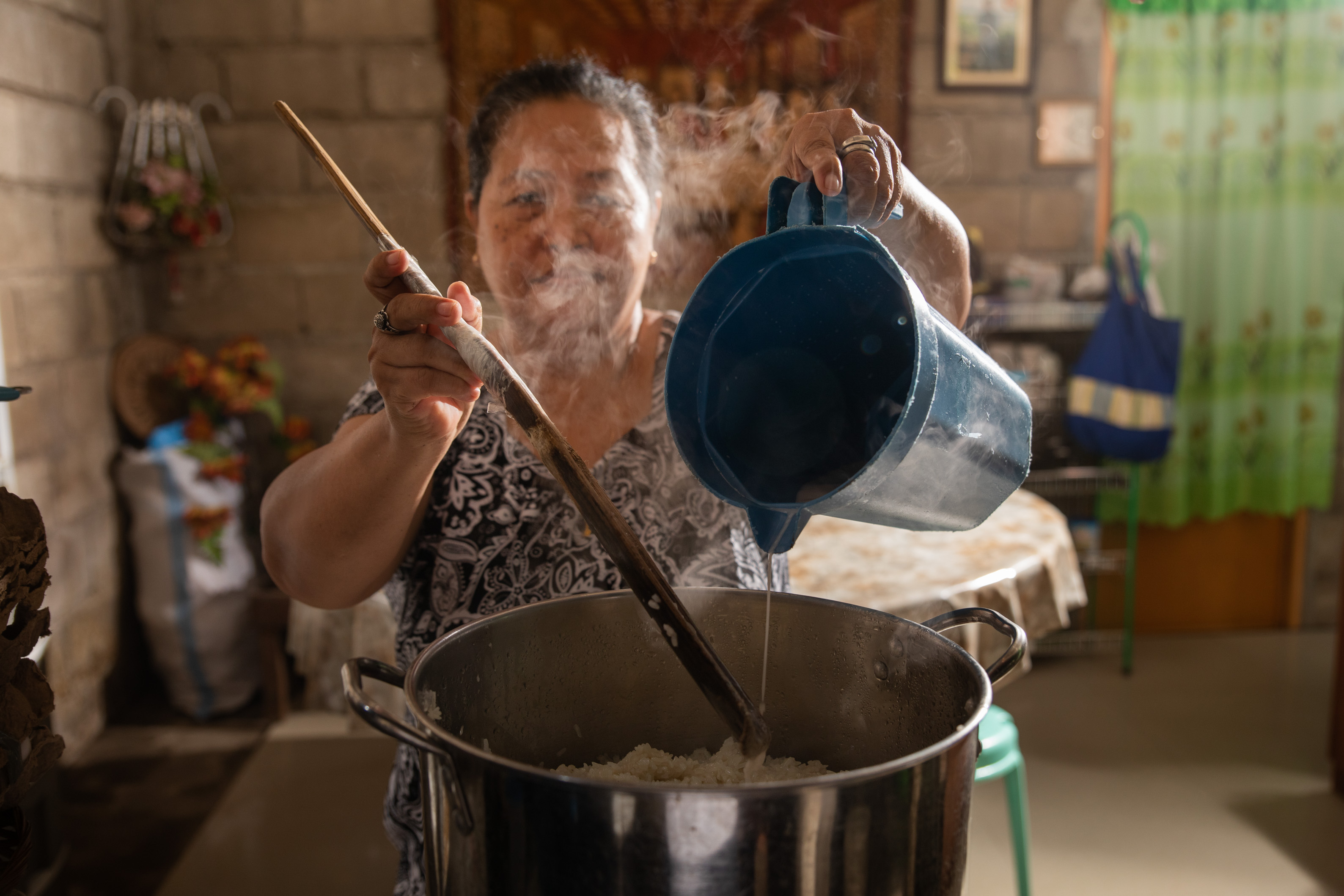



馬孃・貝比 Manang Bebie
在一個颳風下雨的日子,我們杜馬蓋地附近、天氣微涼的巴斯萊(Baslay)與馬孃・貝比・蒙諾波羅(Manang Bebie Monopollo)見面,她答應讓我們看怎麼以水煮的方式製作米糕。她目前在Baslay Highland Brew Café工作,負責製作店內的米糕以及糯米甜點,而店內的咖啡豆來自當地社區共同管理的樹林。沁涼的空氣,以及一座由竹子搭建、三層樓高,可以看到海和阿波島(Apo Island)的瞭望台,使遊客慕名而來。多年來,我常常來這裡協助他們精進咖啡豆的處理流程,這裡已經成為我的第二個家。
巴斯萊人從他們有記憶以來就住在這裡,他們定居的時間久到有人跟我說,要不是他們有受洗信基督教,會被當成原住民。這座山上曾種植過旱稻,不過這項傳統到現在巴斯萊人的祖執輩時就停止了。馬孃・貝比從母親那裡學會製作米糕,而她的母親的手藝承襲自外婆。蒸米糕的製作方式並沒有明確的歷史記載,但我們可以猜測製作方式已經在這個地區流傳好幾千年,畢竟夾在杜馬蓋地與道因(Dauin)中間的巴孔(Bacong)是考古學家發現距今西元五百年前的赤陶米糕蒸籠的出土地。(馬孃・貝比回憶道,當地社群老一輩的人在製作米糕時,仍會用類似的兩件式陶土蒸籠,不過現代人為了方便選擇金屬製的蒸煮器具。我也曾在一間店裡看過兩個蒸煮米糕的人在販售赤陶鍋及陶磚,但是攤商說現今的陶土品質不比以往,如果常使用,使用壽命並不長。)
其實馬孃・貝比以前會蒸米糕,但她現在發現水煮比較合適。雖然咖啡館早上八點開始營業,但客流量很難掌握,需求並沒有高到值得她在天亮之前起來蒸糯米,而且她說,水煮的米糕比較不會走味。
On a rainy and windy day in nearby chilly Baslay, Manang Bebie Monopollo has agreed to show us us the boiling method of making puto maya. She is currently responsible for preparing the puto maya and other rice snacks for the Baslay Highland Brew Cafe, a small shop where they serve the coffee harvested from their community-managed forest. Tourists come for the cool air and the a three-story bamboo viewing deck, from which you can see the ocean and Apo Island. I had been coming here for years to assist them in fine-tuning their coffee processing methods, and it has become my second home.
The people of Baslay have inhabited this place for as long as they could remember, so much so, one of them told me, that they would be considered indigenous people if they were not Christianized. Upland rice was once grown on this mountain, but the tradition ended with the parents of their parents. Manang Bebie learned how to make puto from her mother, who had in turn learned from her own mother. There are no clear historical records around instruction on puto maya, but we can assume that it has been passed down for millennia among generations in this region. After all, Dumaguete and Dauin sandwich the town of Bacong, where archeologists excavated a possible terra cotta puto maya steamer from around 500 BC! (Manang Bebie recounts that the older members of their community still used a similar 2-piece clay implement for such purposes, but these days people opt for the convenience of metal cookware. I also saw a puto steaming duo in a shop selling terra cotta pots and bricks, but the vendor said the quality of current clay deposits cannot match older ones, and it would not last for too long if used often).
Manang Bebie actually used to steam her puto maya, but she now finds it more expedient to boil the rice. After all, the cafe opens at 8AM, but because customer volume can be unpredictable. Demand is not high enough to justify waking before dawn to begin cooking it. Besides, she notes, boiled puto maya keeps better.
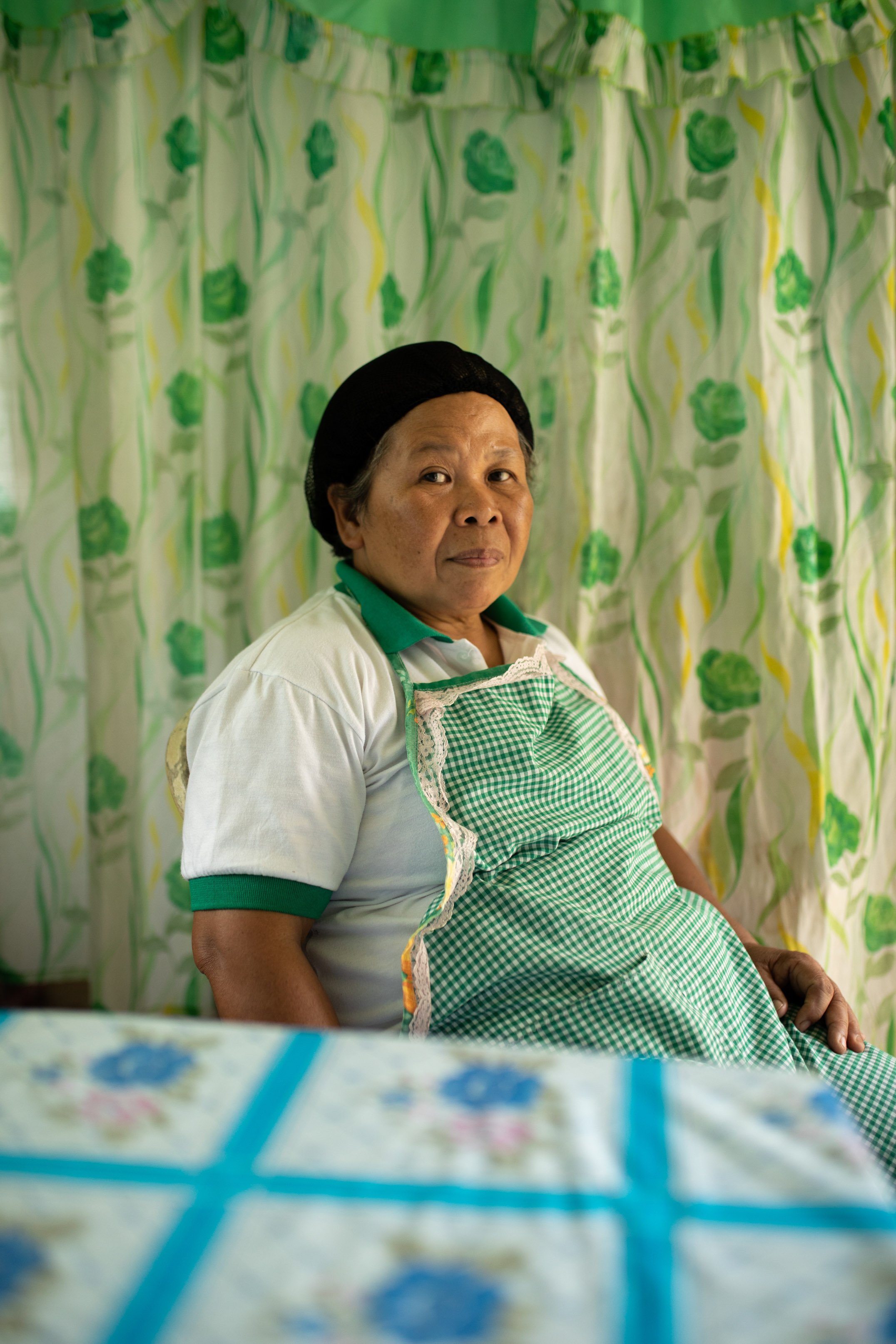



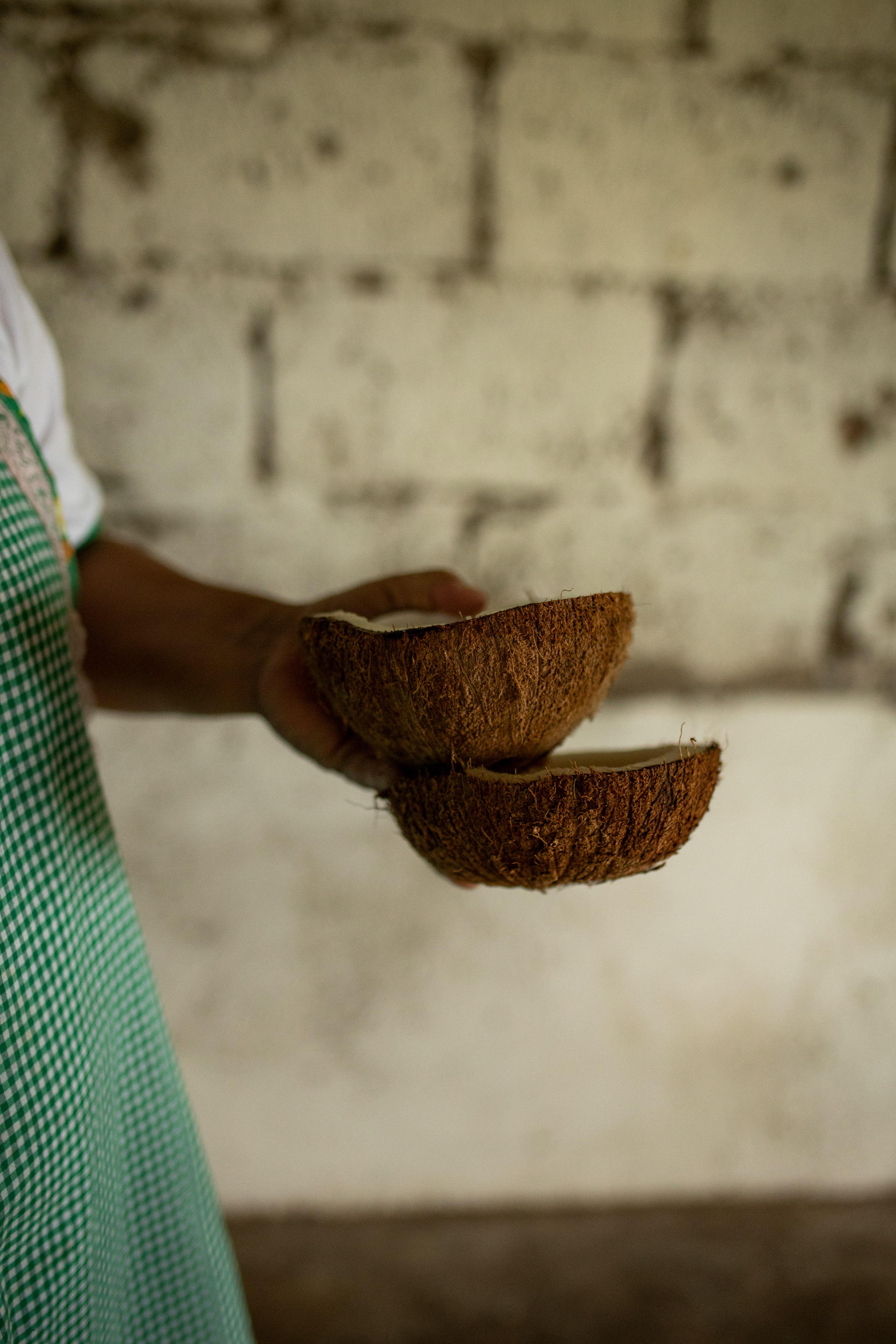
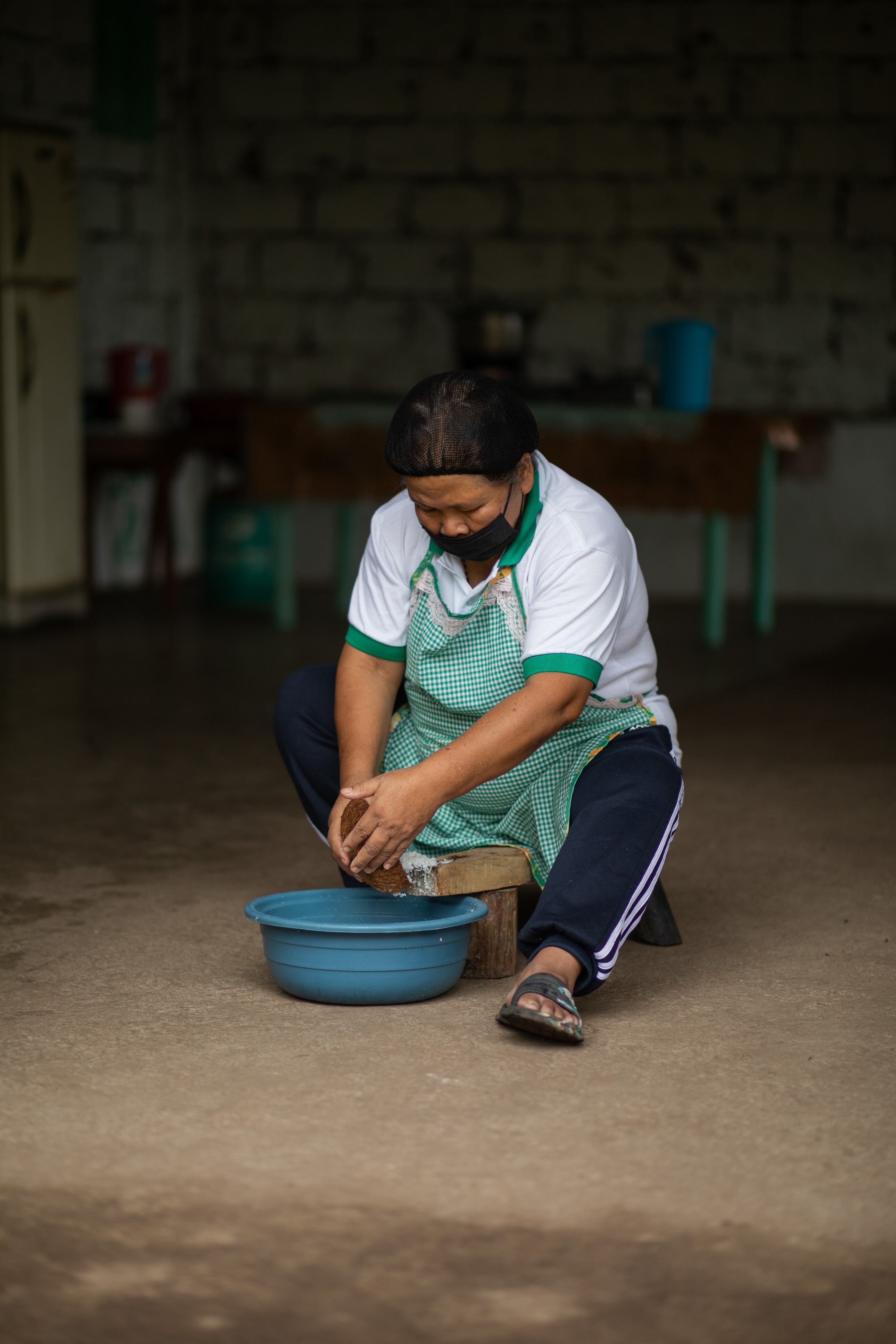

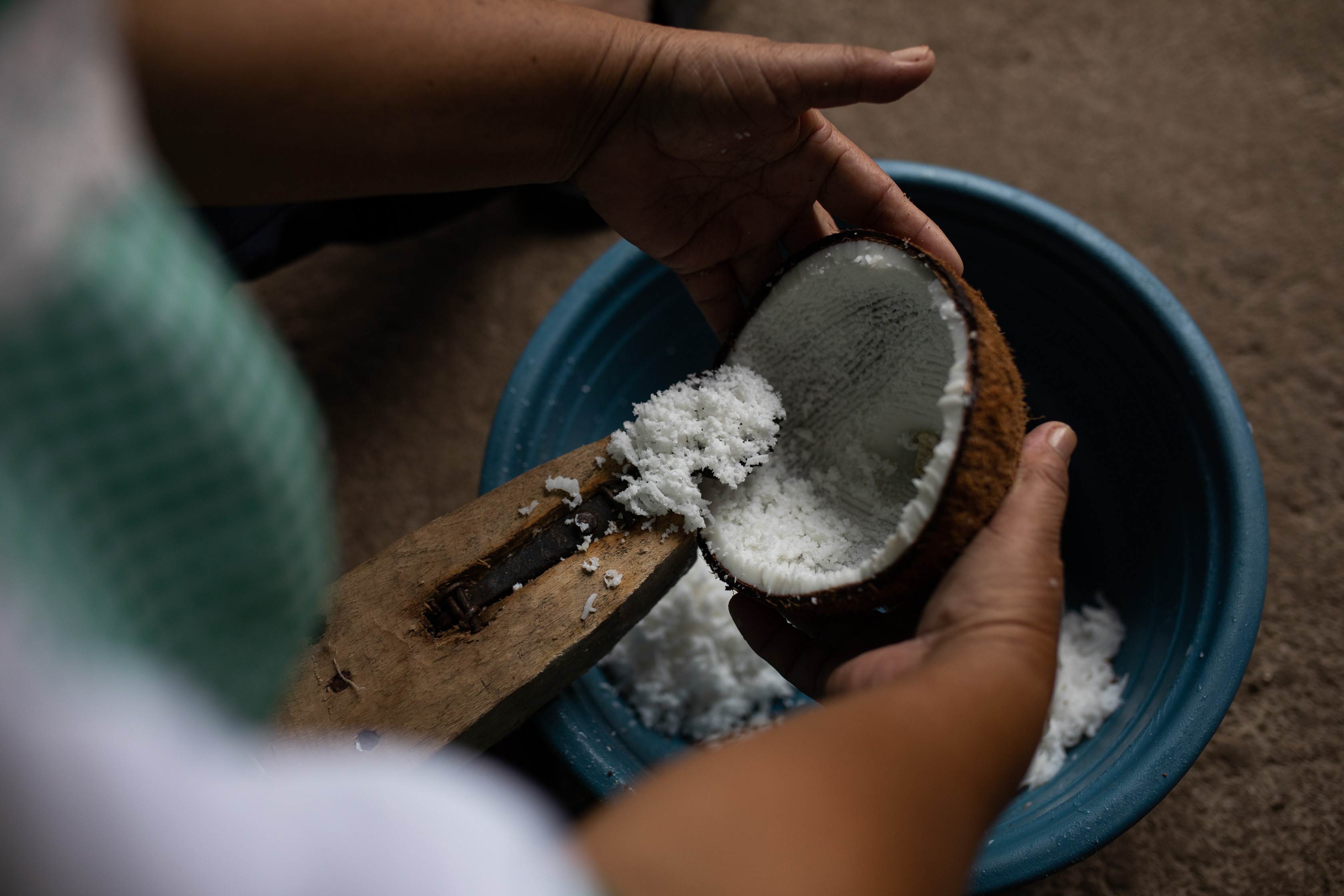


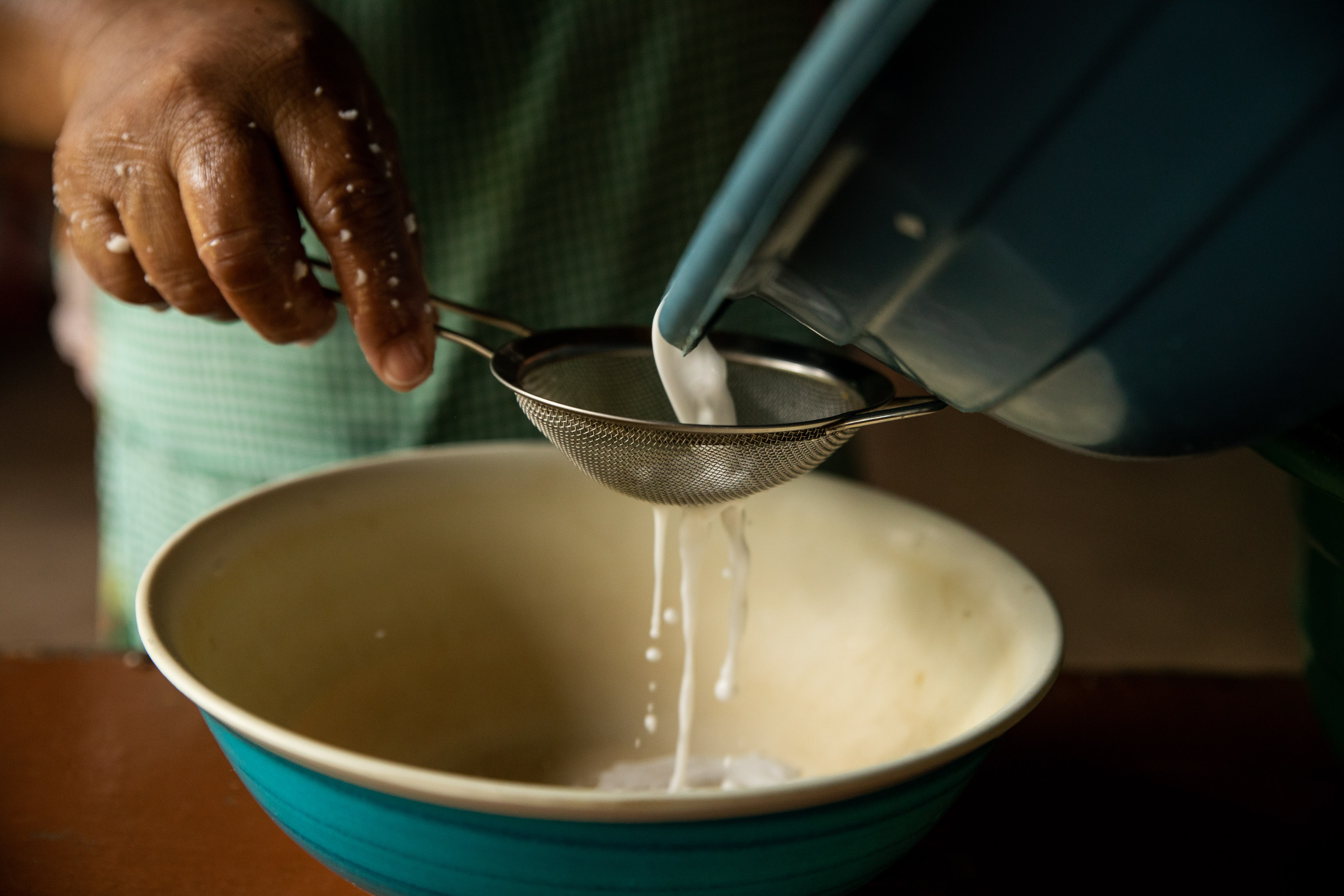
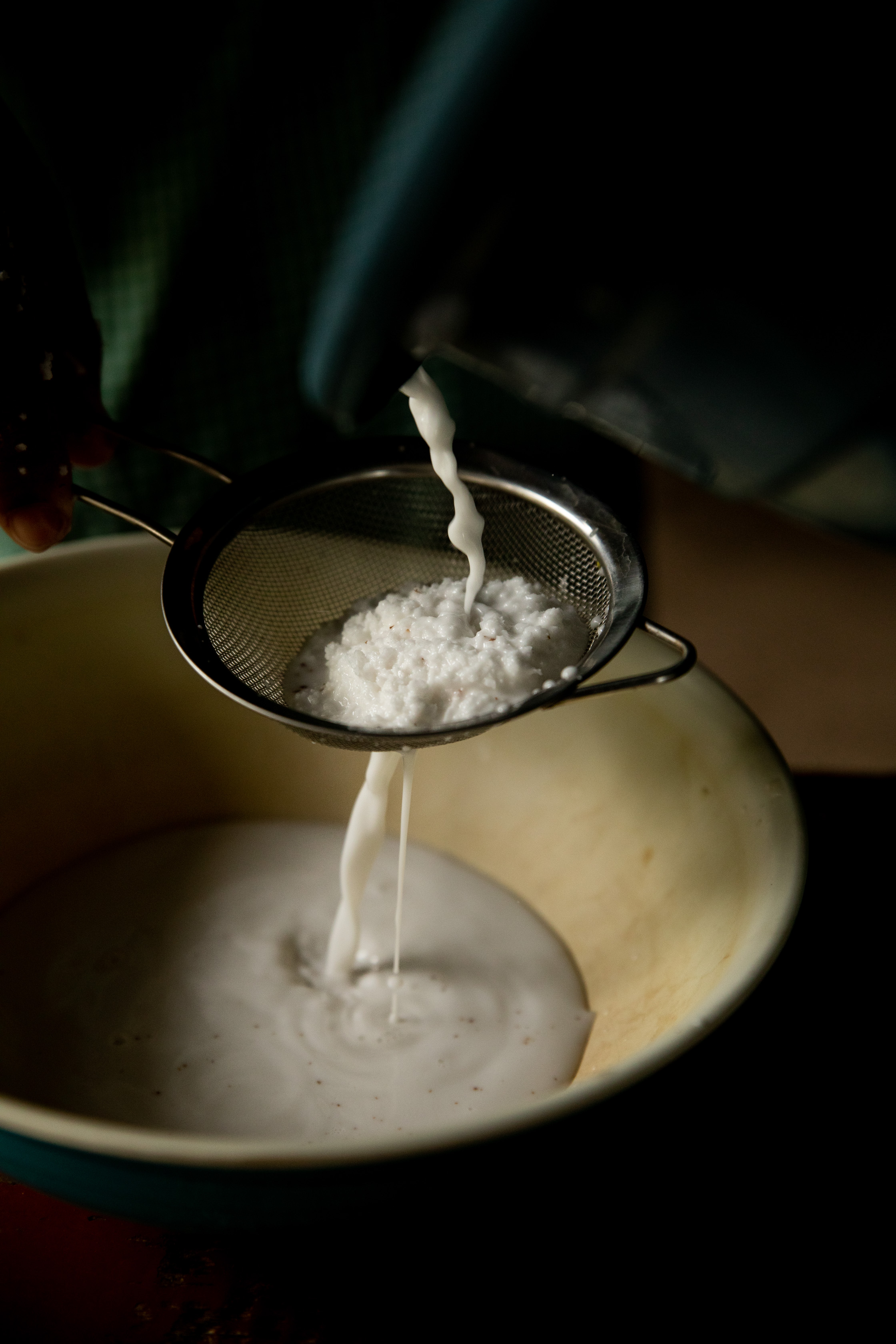
馬孃從把洗過的糯米倒進一個大鍋子開始,然後在鍋裡倒入滿水,接著蓋上蓋子,讓水煮沸,然後把火轉至文火燉煮。蒸煮的時間依使用的糯米種類而有不同(平地的市場賣什麼米,馬孃就買什麼米)。這個方法雖然比較快,但需要時時留神注意,因為米與鍋底直接接觸,有燒焦的風險。
椰奶有加入鹽與糖,不過會在米飯還沒完全熟透的時候倒入一起攪拌。如此一來,椰子的風味能均勻的分佈,充分浸入糯米當中。馬孃再次蓋上鍋蓋,拖著腳步走進廚房把熱可可倒入杯子裡。蒸米糕是在蒸熟離火後才加入椰奶,而水煮米糕因為椰奶充分煮過,比蒸米糕更耐放。
我原本預期米糕是軟糯的口感,但水煮米糕口感扎實,非常入味。不知為何,水煮米糕的甜味比蒸米糕的更明顯直接。馬孃・貝比偏好使用模具一次分好米糕的份量,不讓鍋裡剩下糯米,因為濕氣能幫助米糕定型,就算與空氣接觸也不致於完全乾掉。
我們結束示範過程,最後坐下來吃米糕。沒有什麼能與新鮮出爐的米糕配熱可可相比了。某方面來說,米糕的平凡正是它能帶來滿足的原因:既沒有正餐的飽足感,也不會精緻到讓人覺得高攀不起。我們邊聊天邊讚嘆米糕搭配熱可可的美味如此純粹,還有這片山林使我們想起世界曾經的樣子。我每咬一口,都感謝遠方的原住民透過大帆船與我們分享他們的文化,也感謝在我們腳下塵土安息的先民為各自的社群種植稻米、製作米糕。
She begins by pouring rinsed sticky rice into a large pot and then filling it with water. She covers it, brings it to a boil, and lowers the fire to generate a simmer. Cooking time varies according to what rice you use (she chooses whatever is available in the lowland market). This method may be quicker, but it also necessitates a closer eye, as direct contact with the bottom of the pot creates a risk of burning the rice.
Coconut milk is mixed with salt and sugar, but is poured in and mixed when the rice is not completely cooked yet. This way, the coconut flavor is distributed well and permeates through the grain. She covers the pot again and shuffles to the kitchen to pour the tsokolate out into cups. Because the coconut milk is cooked well, the puto does not spoil as quickly as the steamed ones, in which the milk is added after the rice is removed from the fire.
I was expecting the resulting puto to be mushy, but it was firm and delicious. For some reason, it was a lot more forward in its sweetness than the steamed varieties. Manang Bebie prefers to use a mold (another repurposed round plastic container) to aportion out everything at once instead of letting the rice rest in the pot, as the moisture allows them to hold up without drying out even when exposed to air.
We wrapped up the demonstration and finally sat down to eat. There is really quite nothing like freshly made puto maya and tsokolate. In a way, its straightforwardness makes it conducive to conviviality: not substantial enough to be a full meal, not elaborate enough to merit refusal out of modesty. We chat and marvel at the delicious simplicity of the pairing, the forest that reminds us of how the world used to be. With each bite, I give thanks to a faraway indigenous peoples that shared its culture with us through the Galleons, and also to those in burial grounds under our feet who grew rice and prepared it for their communities.
椰奶有加入鹽與糖,不過會在米飯還沒完全熟透的時候倒入一起攪拌。如此一來,椰子的風味能均勻的分佈,充分浸入糯米當中。馬孃再次蓋上鍋蓋,拖著腳步走進廚房把熱可可倒入杯子裡。蒸米糕是在蒸熟離火後才加入椰奶,而水煮米糕因為椰奶充分煮過,比蒸米糕更耐放。
我原本預期米糕是軟糯的口感,但水煮米糕口感扎實,非常入味。不知為何,水煮米糕的甜味比蒸米糕的更明顯直接。馬孃・貝比偏好使用模具一次分好米糕的份量,不讓鍋裡剩下糯米,因為濕氣能幫助米糕定型,就算與空氣接觸也不致於完全乾掉。
我們結束示範過程,最後坐下來吃米糕。沒有什麼能與新鮮出爐的米糕配熱可可相比了。某方面來說,米糕的平凡正是它能帶來滿足的原因:既沒有正餐的飽足感,也不會精緻到讓人覺得高攀不起。我們邊聊天邊讚嘆米糕搭配熱可可的美味如此純粹,還有這片山林使我們想起世界曾經的樣子。我每咬一口,都感謝遠方的原住民透過大帆船與我們分享他們的文化,也感謝在我們腳下塵土安息的先民為各自的社群種植稻米、製作米糕。
She begins by pouring rinsed sticky rice into a large pot and then filling it with water. She covers it, brings it to a boil, and lowers the fire to generate a simmer. Cooking time varies according to what rice you use (she chooses whatever is available in the lowland market). This method may be quicker, but it also necessitates a closer eye, as direct contact with the bottom of the pot creates a risk of burning the rice.
Coconut milk is mixed with salt and sugar, but is poured in and mixed when the rice is not completely cooked yet. This way, the coconut flavor is distributed well and permeates through the grain. She covers the pot again and shuffles to the kitchen to pour the tsokolate out into cups. Because the coconut milk is cooked well, the puto does not spoil as quickly as the steamed ones, in which the milk is added after the rice is removed from the fire.
I was expecting the resulting puto to be mushy, but it was firm and delicious. For some reason, it was a lot more forward in its sweetness than the steamed varieties. Manang Bebie prefers to use a mold (another repurposed round plastic container) to aportion out everything at once instead of letting the rice rest in the pot, as the moisture allows them to hold up without drying out even when exposed to air.
We wrapped up the demonstration and finally sat down to eat. There is really quite nothing like freshly made puto maya and tsokolate. In a way, its straightforwardness makes it conducive to conviviality: not substantial enough to be a full meal, not elaborate enough to merit refusal out of modesty. We chat and marvel at the delicious simplicity of the pairing, the forest that reminds us of how the world used to be. With each bite, I give thanks to a faraway indigenous peoples that shared its culture with us through the Galleons, and also to those in burial grounds under our feet who grew rice and prepared it for their communities.
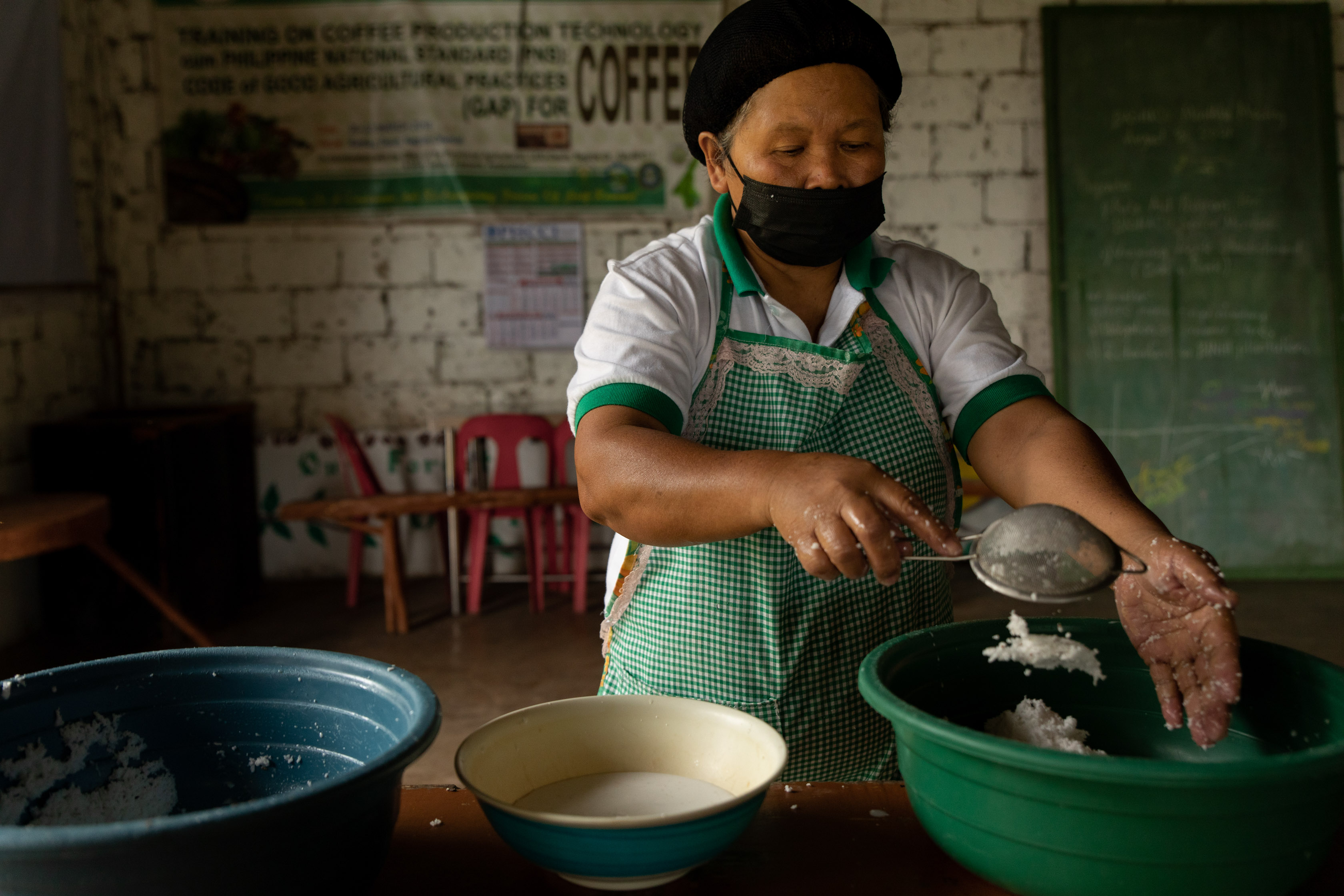
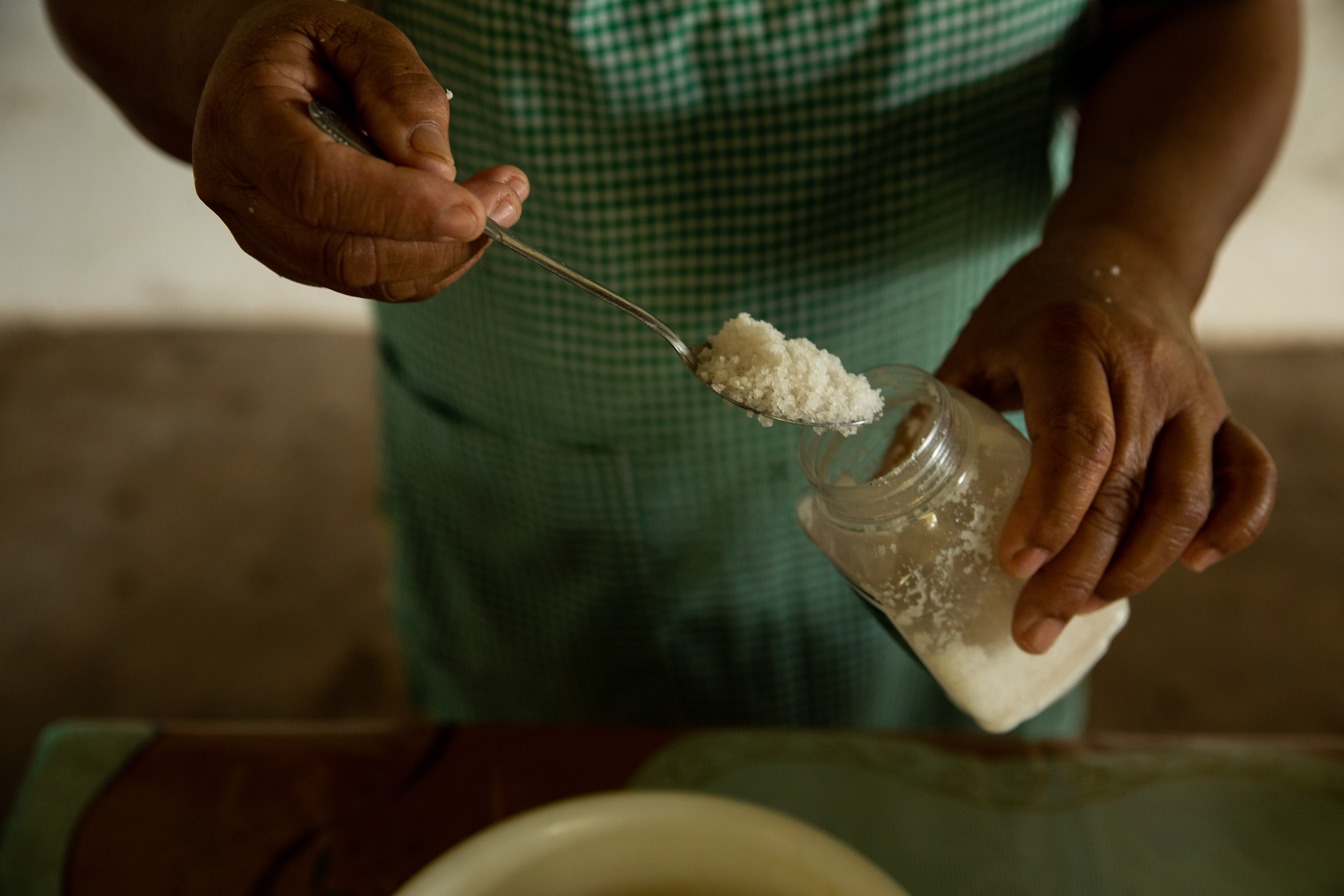


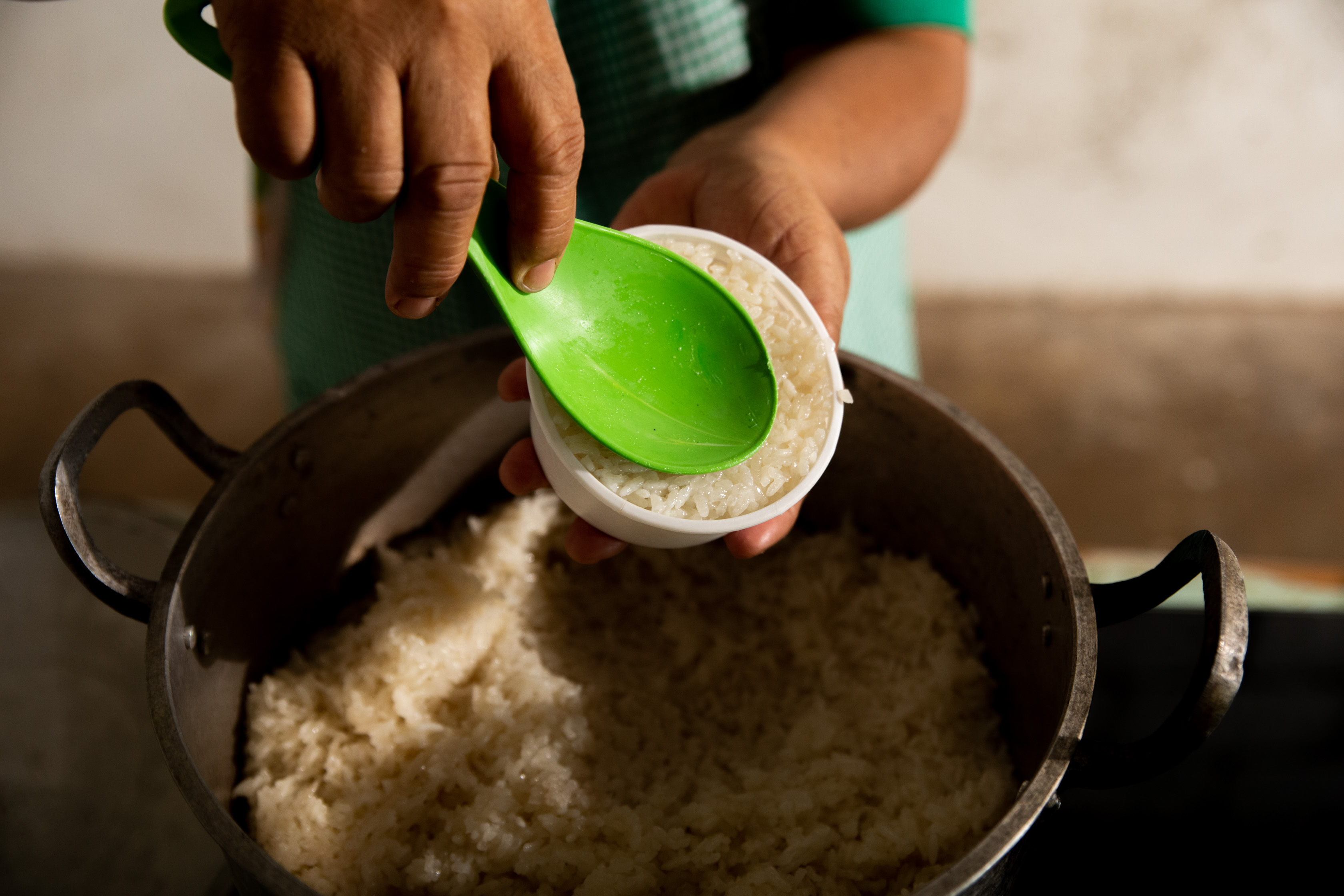

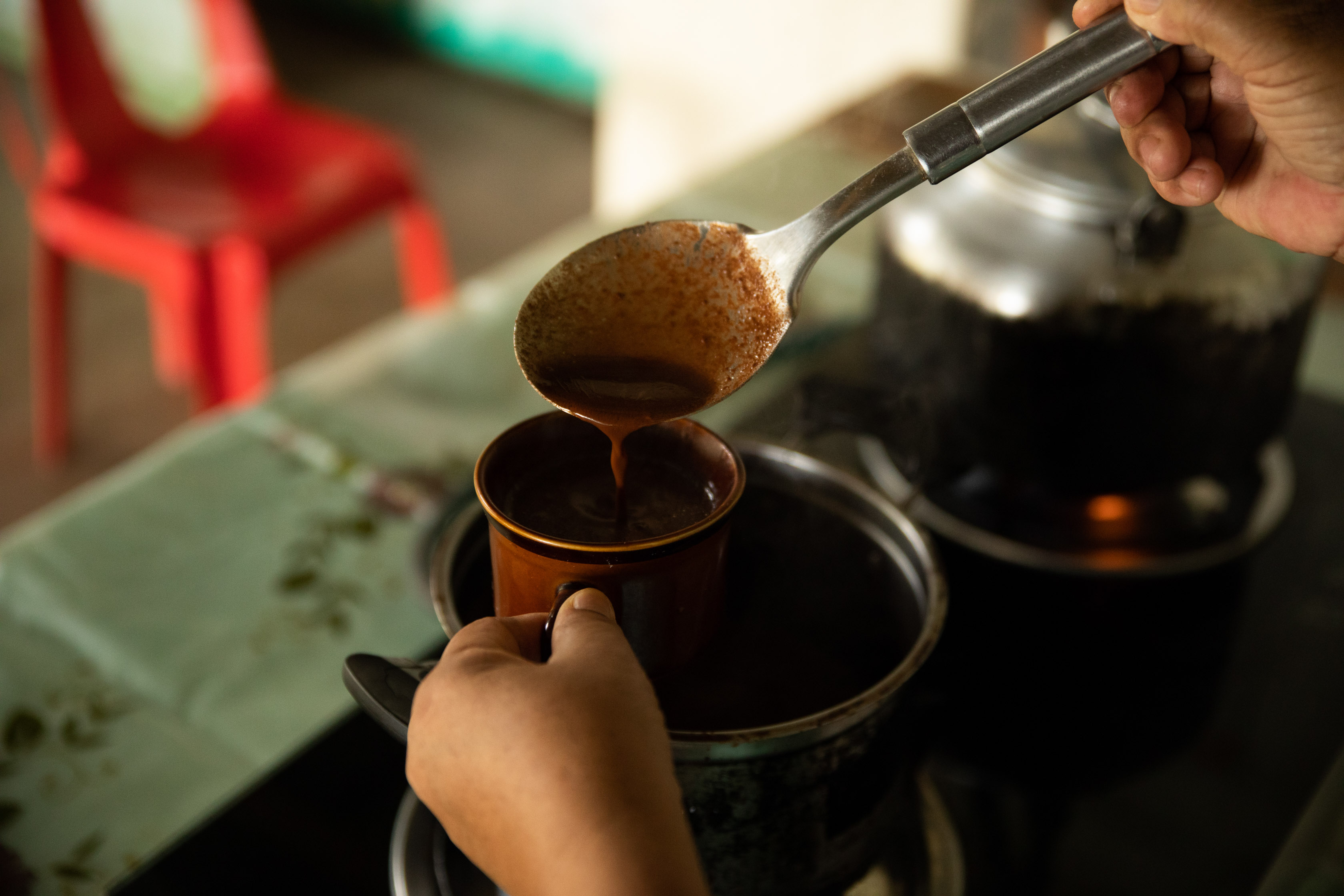

阿莫姊姊的蒸米糕
食材
白糯米:2公斤水(浸泡用)
熟成椰子:3片(需碾碎)
水:4杯
鹽:3湯匙
糖:5 湯匙
備料步驟
1. 將米泡水20分鐘至1小時。2. 放入糯米前,在蒸籠中將水煮沸。將米放入蒸籠後,蒸煮30分鐘至1小時。檢查水位,若水位見底再行添加。
3. 燉煮期間,將碾碎的椰子拌入水。將椰奶擠出,並進行篩濾。在椰奶中加入鹽與糖,並充分攪拌。將攪拌過的椰奶進行篩濾。
4. 由於有些地方可能熟的比較快,用抹刀戳米糕各處,讓蒸氣均勻散布。米糕完全熟透的指標:抹刀或飯勺插入米糕時,不會感受到尚未熟透的米粒的阻力,因為米粒都蒸熟了,應該會是很滑順的感覺。
5. 蒸熟之後,關火並在蒸籠內倒入加了鹽與糖的椰奶。請充分攪拌。米糕應在溫熱時與熱可可一同出餐。
ATE MELDY’S STEAMED PUTO MAYA
INGREDIENTS
2 kg white sticky riceWater for soaking
3 pcs mature coconut, grated
4 cups water
3 tablespoons salt
5 tablespoons sugar
DIRECTIONS
1. Soak the rice in water for 20minutes to 1 hour.2. Boil water in steamer before putting the sticky rice. Place rice inside steamer basket and steam for 30 minutes to an hour. Check water levels and add more if is running out.
3. In the meantime, mix grated coconut with water. Squeeze coconut milk out and strain. Add salt and sugar into coconut milk and mix very well. Strain the coconut milk mixture.
4. Poke different parts of the mass of rice with a spatula to distribute the steam, as some parts may cook before others. Check for doneness of rice: When you insert a spatula or paddle into the steaming rice, you should not feel resistance from uncooked grains. It should feel smooth due to the absence of uncooked grain.
5. Once rice is done, turn heat off and pour the coconut milk mixture inside. Mix very well. Serve warm with a cup of hot cacao.

阿莫姊姊的熱可可
材料
未加糖的可可片:8 片(800 公克)水:10.85公升
黑糖:3公斤
備料步驟
1. 用將近一半的水溶解黑糖。用文火燉煮,直到糖溶解。2. 將剩下的水分倒入鍋中,以中火加熱。加入可可片。待水開始滾沸時,把火轉小,不斷攪拌至其乳化。請記得攪拌鍋底,避免可可片在鍋底燒焦。最後,可可片會全部溶解。持續攪拌以確保固體可可與油脂充分與水融合。
3. 將黑糖與熱可可加在一起,繼續開小火攪拌。鍋子離火,出餐。
ATE MELDY’S TSOKOLATE OR CACAO
INGREDIENTS
8 packs (800 grams) of unsweetened cacao tablea10.85 liters water
3 kilos brown sugar
DIRECTIONS
1. Dissolve the brown sugar in approximately ½ of the water. Simmer in a pot over low heat until sugar is dissolved.2. Heat the remaining water in a pot over medium heat. Add the cacao tablea. When water begins to boil, reduce the fire and stir constantly to emulsify. Make sure to scrape the bottom of the pot to remove any solids that may burn. Eventually, all the bits will dissolve. Keep stirring to ensure that the solids and fat incorporate well into the water.
3. Combine both and keep stirring under low heat. Remove from heat and serve.

貝比姊姊的水煮米糕
材料
糯米:11 杯水:11.5 杯
熟成椰子:1 顆(需碾碎)
水:2 杯
鹽:2 湯匙
糖:4 湯匙
備料步驟
1. 將糯米和11.5杯的水放入大鍋中,將水煮沸後轉小火。在燉煮時,請蓋上鍋蓋,並不時查看是否完全煮熟。2. 燉煮期間,將碾碎的椰子拌入水。將椰奶擠出,並進行篩濾。在椰奶中加入鹽與糖,並充分攪拌。將攪拌過的椰奶進行篩濾。
3. 在米煮到¾的熟度時,倒入加了鹽與糖的椰奶,並充分攪拌。再次放回爐上,蓋上鍋蓋。請不時檢查,確認糯米沒燒焦。糯米煮熟後,離火,並在溫熱時出餐。
ATE BEBIE’S BOILED PUTO MAYA
INGREDIENTS
11 cups sticky rice11.5 cups water
1 mature coconut, grated
2 cups water
2 tablespoons of salt
4 tablespoon of sugar
DIRECTIONS
1. Place sticky rice and 11.5 cups of water in a large pot. Bring to a boil and lower heat. Cover as the rice simmers, checking often for doneness.
2. In the meantime, mix grated coconut with water. Squeeze coconut milk out and strain. Add salt and sugar into coconut milk and mix very well. Strain the coconut milk mixture.
3. When rice is about ¾ done, add the coconut milk mixture and mix very well. Return to the fire and cover. Check often to make sure the rice does not burn. When rice is cooked, remove from fire and serve warm.
